Delaware, located in the Mid-Atlantic region of the United States, is home to a diverse array of bird species throughout the year.
However, the winter season brings about a unique spectacle as numerous avian species migrate to and through the region, adding vibrancy to the otherwise cold and barren landscape.
Winter birds in Delaware offer bird enthusiasts and casual observers alike a captivating display of color, behavior, and survival skills.
From elegant waterfowl to acrobatic woodpeckers, these winter visitors bring delight and wonder to nature enthusiasts during the colder months.
In this article, we will explore the notable winter bird species that can be spotted in Delaware, offering a glimpse into the fascinating world of these resilient creatures adapting to the challenges of the season.
1. American Goldfinch
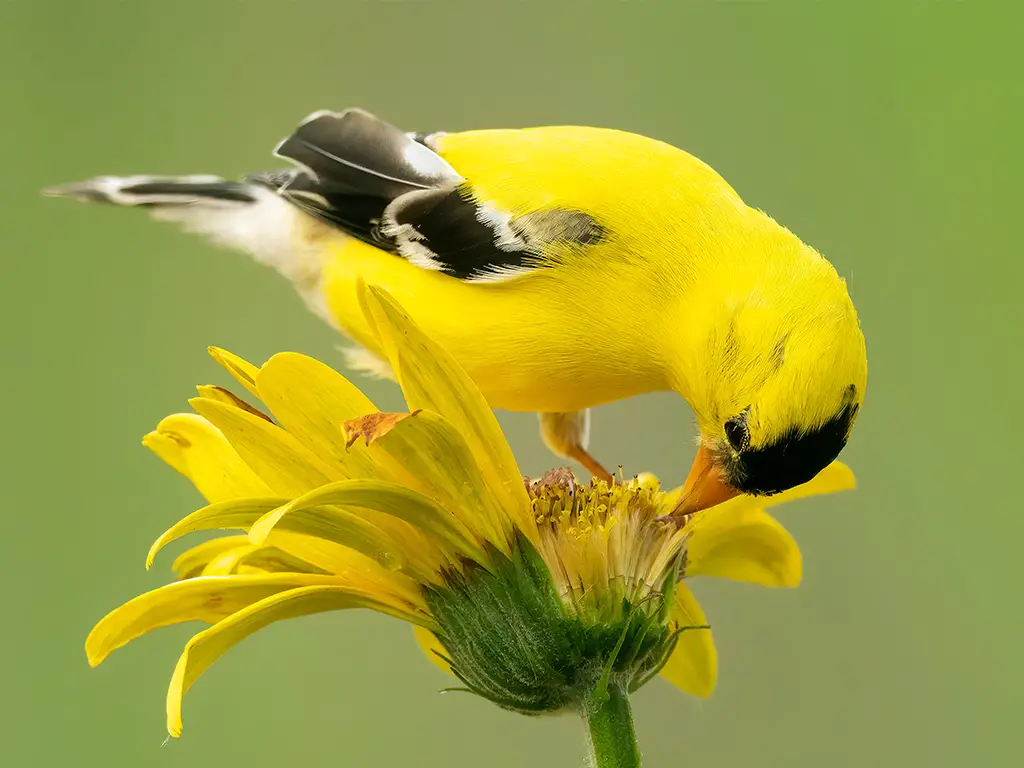
The American goldfinch is a type of bird that is found in North America.
It belongs to the finch family, which is a group of small birds known for their colorful feathers and pleasant songs. This bird is migratory, meaning it travels from one place to another depending on the time of year.
During the breeding season, which is when they mate and lay eggs, the American goldfinch can be found in an area ranging from mid-Alberta in Canada to North Carolina in the United States. In the winter, when the weather gets colder, the American goldfinch migrates to a different region.
They move from just south of the Canada–United States border and travel down to Mexico.
This helps them find better conditions for survival, as the temperature and food availability change with the seasons. The reason for their migration is mainly related to the availability of food.
During the breeding season, the American goldfinch feeds on insects and seeds from plants like sunflowers and thistles.
These food sources are abundant in the areas where they breed, providing them with the necessary nutrients for reproduction and raising their young. However, during the winter, these insects and plants may not be readily available in their breeding grounds.
| Kingdom | Animalia |
| Phylum | Chordata |
| Clade | Dinosauria |
| Class | Aves |
| Order | Passeriformes |
| Family | Fringillidae |
| Genus | Spinus |
| Species | S. tristis |
2. Red-Bellied Woodpecker
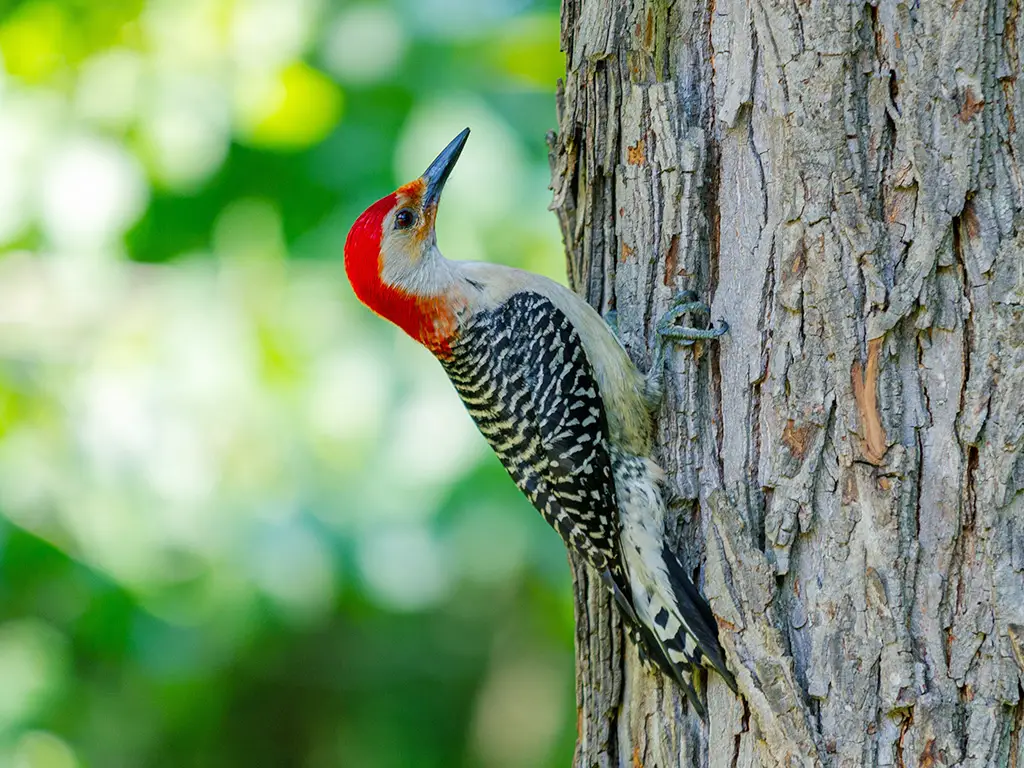
The red-bellied woodpecker is a type of bird that belongs to the family Picidae. It is not too big or too small; it is considered to be a medium-sized woodpecker.
This means that it is smaller than some other woodpecker species but larger than others. These woodpeckers are found primarily in the eastern part of the United States. However, they can also be seen in other areas.
They have a wide range, stretching from as far south as Florida to as far north as Canada. This means that they can be found in many different states and provinces within these regions. When it comes to their appearance, the red-bellied woodpecker has some distinct features.
As the name suggests, they have a red belly, although this may not be immediately noticeable. Their belly is more of a pale or dull red color, compared to other parts of their body.
They also have a red cap on the top of their head, which is more vibrant and noticeable. In addition to their red belly and cap, these woodpeckers have a black and white pattern on their back, wings, and tail.
The black feathers provide a nice contrast against the white feathers, creating a visual.
| Kingdom | Animalia |
| Phylum | Chordata |
| Clade | Dinosauria |
| Class | Aves |
| Order | Piciformes |
| Family | Picidae |
| Genus | Melanerpes |
| Species | M. carolinus |
3. House Finch
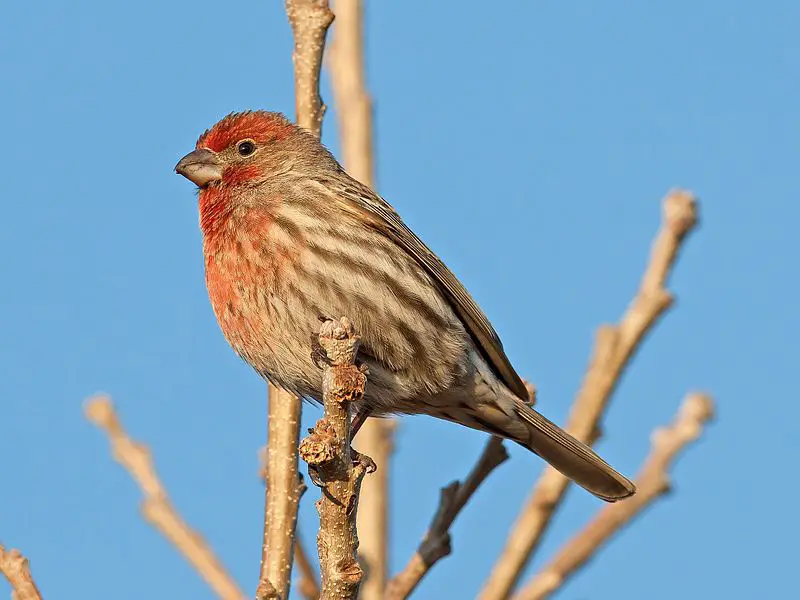
The house finch is a type of bird that belongs to the finch family called Fringillidae. This bird is originally from western North America.
However, it has also been introduced to other parts of the continent, such as the eastern half, as well as Hawaii. The house finch is not the only bird in its genus.
It is grouped with two other American rosefinches, and all three are placed in the genus Haemorhous. The house finch is known for its beautiful red coloration, especially in males. The males have a reddish hue on their heads, chests, and backs.
Females, on the other hand, have more muted colors, with brownish feathers. These birds are relatively small in size, measuring about 12 to 16 centimeters in length. They have short wings and a slightly notched tail.
Their beaks are conical in shape and designed for cracking open seeds, which are their primary source of food. House finches are highly adaptable and can be found in a variety of habitats, including urban areas, forests, and grasslands.
They are known for their melodious songs, which they use to communicate and attract mates. Breeding season for these.
| Kingdom | Animalia |
| Phylum | Chordata |
| Clade | Dinosauria |
| Class | Aves |
| Order | Passeriformes |
| Family | Fringillidae |
| Genus | Haemorhous |
| Species | H. mexicanus |
4. Purple Finch
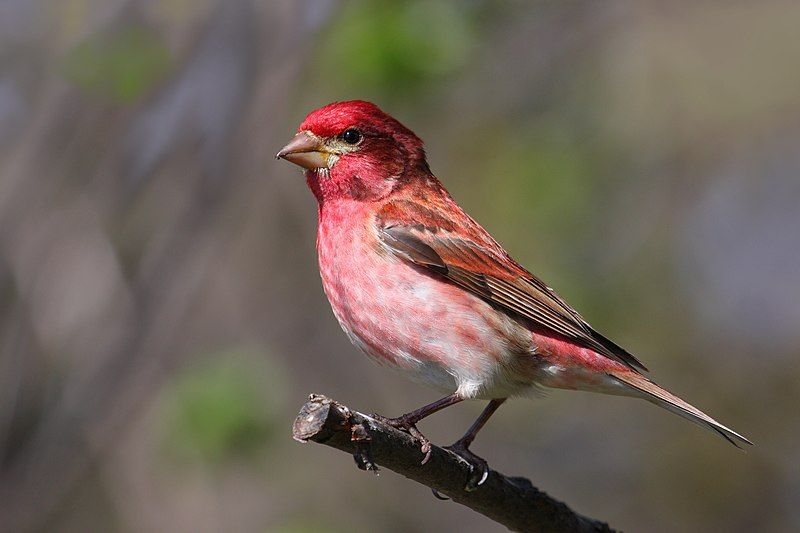
The purple finch is a type of bird. It belongs to the finch family called Fringillidae. This family includes various species of finches. The purple finch is one of them. This bird is found in different parts of North America.
It breeds in the northern United States, which means it lays eggs and raises its young there. It also breeds in southern Canada, which is the region located below the northern part of Canada.
Additionally, the bird can be found along the west coast of North America. Breeding refers to the process of reproduction in animals, where they mate and produce offspring. Birds, like the purple finch, build nests and lay eggs for breeding.
They take care of their eggs until they hatch, and then they raise their chicks until they are ready to leave the nest. The purple finch is known for its vibrant purple coloration.
Males have a deep red or raspberry-colored plumage with a purple tint, while females have a more subdued plumage with streaks of brown and white.
This difference in appearance between males and females is called sexual dimorphism. In addition to its striking color, the purple finch has a sturdy beak that is well-suited for cracking open seeds.
| Kingdom | Animalia |
| Phylum | Chordata |
| Clade | Dinosauria |
| Class | Aves |
| Order | Passeriformes |
| Family | Fringillidae |
| Genus | Haemorhous |
| Species | H. purpureus |
5. Northern Cardinal
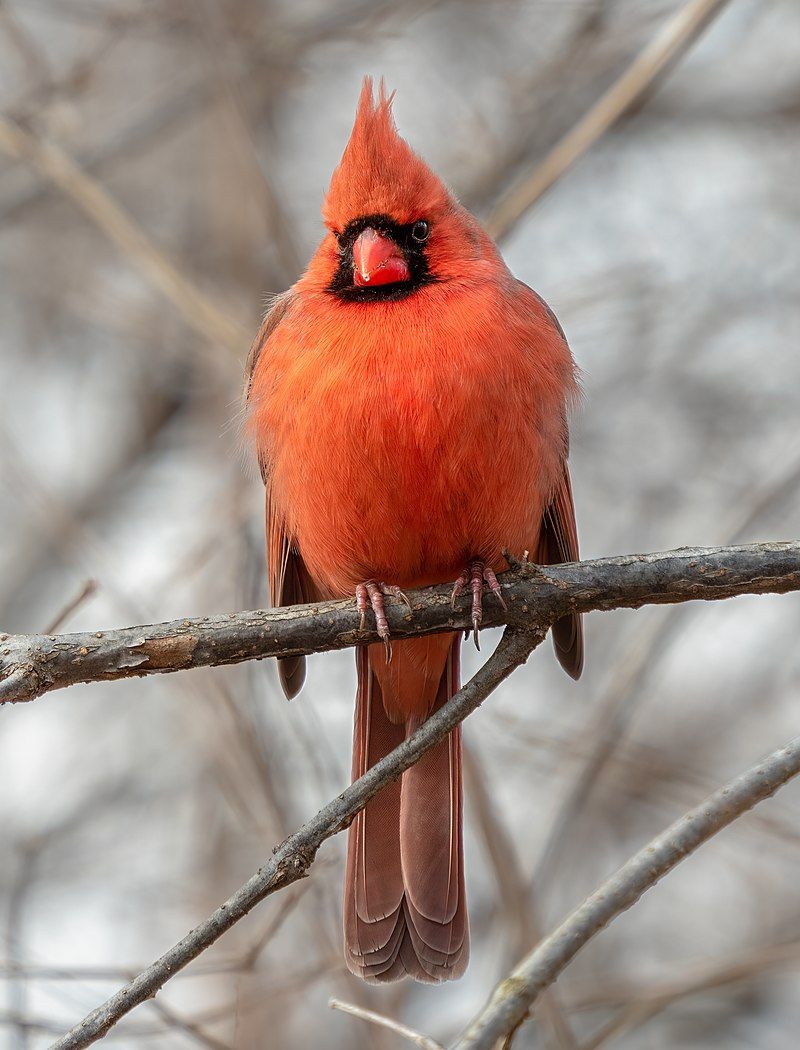
The northern cardinal is a type of bird that is commonly referred to by different names such as redbird, common cardinal, red cardinal, or simply cardinal.
It belongs to the genus Cardinalis. The cardinal is primarily found in North America, particularly in regions such as the United States, Canada, and Mexico. It is known for its vibrant red plumage, which is more prominent in males than females.
The male cardinal has a distinctive crest on its head, while the female has a reddish tinge on its feathers. These birds are often observed in various habitats, including woodlands, gardens, and urban areas.
They are adaptable to different environments and can thrive in both rural and suburban settings.
Cardinals are also known for their beautiful songs, which are melodic and often used for communication and territorial marking. In terms of diet, the cardinal is omnivorous, meaning it eats a variety of foods.
Its diet consists of seeds, fruits, insects, and occasionally small reptiles or amphibians.
They have a strong beak that allows them to crack open seeds and fruits with ease. During the breeding season, which typically occurs in spring and early summer, cardinals engage in courtship rituals. The male cardinal displays its vibrant red plum.
| Kingdom | Animalia |
| Phylum | Chordata |
| Clade | Dinosauria |
| Class | Aves |
| Order | Passeriformes |
| Family | Cardinalidae |
| Genus | Cardinalis |
| Species | C. cardinalis |
6. Mourning Dove
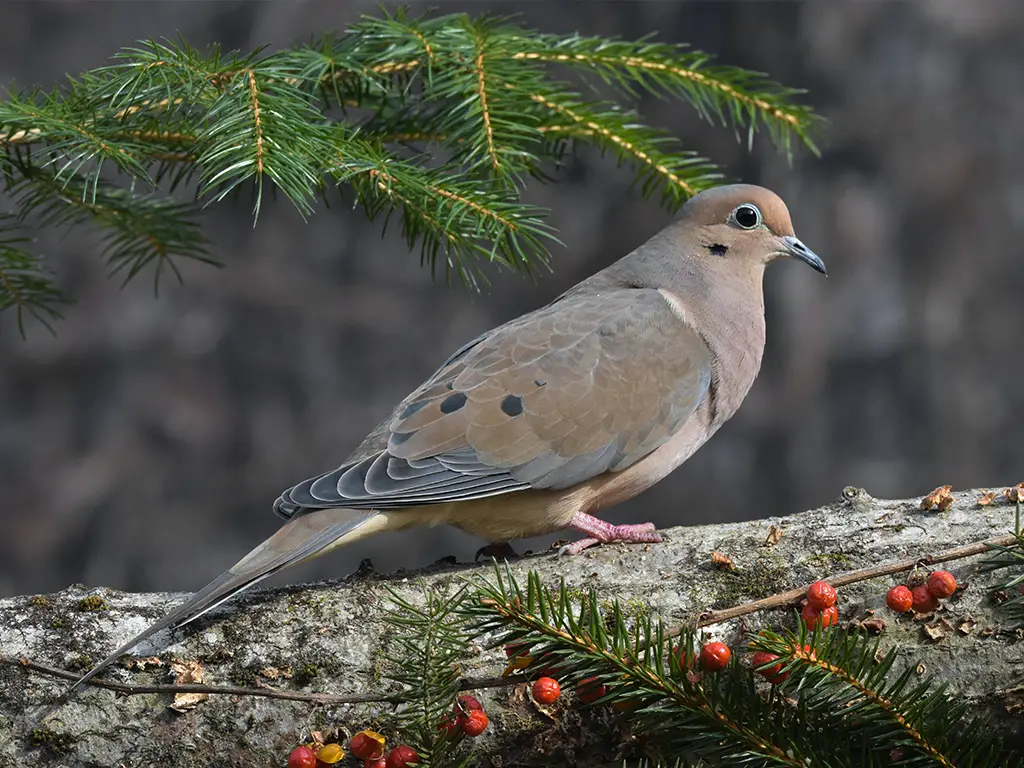
The mourning dove is a type of bird that belongs to the dove family called Columbidae. This bird is also known by different names such as the American mourning dove, the rain dove, colloquially as the turtle dove.
In the past, it was referred to as the Carolina pigeon and Carolina turtledove. The mourning dove is a common species found in North and Central America. It is recognized for its soft, mournful cooing sound, which gives it its name.
This bird is known for its slender body and long, pointed tail. It has a grayish-brown color with lighter shades on its underparts. One interesting fact about mourning doves is their ability to adapt to various habitats.
They can be found in different environments like forests, fields, urban areas, and even deserts. They are known to thrive in both rural and suburban settings. Mourning doves primarily feed on seeds, grains, and fruits.
They have a unique diet as they can swallow seeds whole and store them in their crop, a specialized part of their digestive system. This allows them to eat in one location and then retreat to a safer place to digest their food. These birds are monogamous, meaning they mate.
| Kingdom | Animalia |
| Phylum | Chordata |
| Clade | Dinosauria |
| Class | Aves |
| Order | Columbiformes |
| Family | Columbidae |
| Genus | Zenaida |
| Species | Z. macroura |
7. White-Throated Sparrow
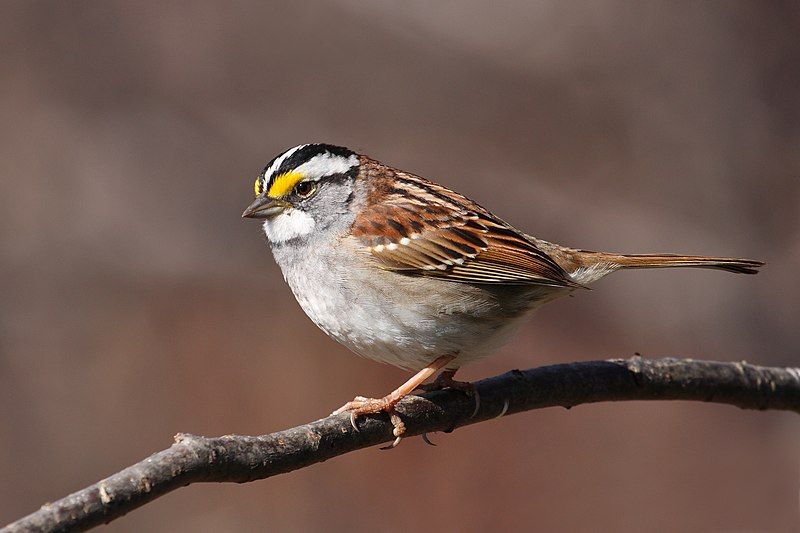
The white-throated sparrow is a type of bird that belongs to the passerine family called Passerellidae. This family of birds is commonly known as New World sparrows. Passerines are a diverse group of birds that make up more than half of all bird species.
They are known for their unique ability to perch and grip onto branches with their feet. The white-throated sparrow, specifically, is easily distinguished by the white patch on its throat. This feature gives the bird its name.
These sparrows are native to North America and can be found throughout the continent, from Canada to Mexico. They are migratory birds, meaning they travel long distances during certain times of the year.
During the breeding season, white-throated sparrows are known for their distinct song, which can be described as a whistling “Oh sweet Canada, Canada, Canada.” This song helps them attract mates and establish their territory.
White-throated sparrows are relatively small birds, measuring about 6 to 7 inches in length. They have a plump body with a rounded head and a short tail. Their plumage consists of a combination of gray, brown, and black feathers.
| Kingdom | Animalia |
| Phylum | Chordata |
| Clade | Dinosauria |
| Class | Aves |
| Order | Passeriformes |
| Family | Passerellidae |
| Genus | Zonotrichia |
| Species | Z. albicollis |
8. American Robin
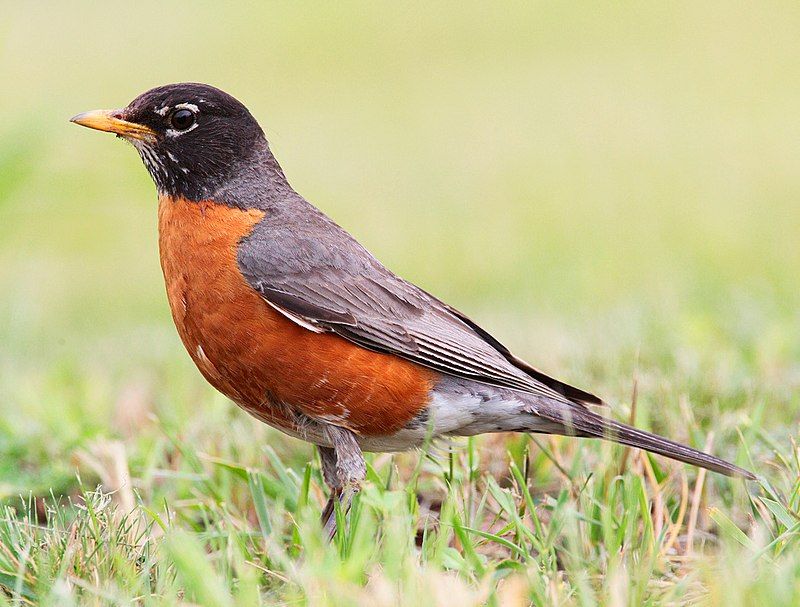
The American robin is a type of bird that migrates. It belongs to the true thrush genus and the Turdidae family, which is a larger family of thrushes. It gets its name from the European robin because of its reddish-orange breast.
However, it is important to note that the American robin and the European robin are not closely related. The European robin is a different species and belongs to the Old World flycatcher family.
Despite their similar names and physical characteristics, these two birds are not closely related in terms of their genetic makeup.
They may share some similarities in appearance, such as the reddish-orange breast, but their evolutionary paths have taken them in different directions. The American robin is primarily found in North America, while the European robin is native to Europe and parts of Asia.
Both species have adapted to their respective environments and habitats over time.
The American robin is known for its ability to migrate long distances, often traveling south during the winter months and returning north for breeding season. In terms of physical characteristics, the American robin is larger than the European robin.
It has a grayish-brown back and a distinct reddish-orange breast, which is a defining feature of the species.
| Kingdom | Animalia |
| Phylum | Chordata |
| Clade | Dinosauria |
| Class | Aves |
| Order | Passeriformes |
| Family | Turdidae |
| Genus | Turdus |
| Species | T. migratorius |
9. Tufted Titmouse
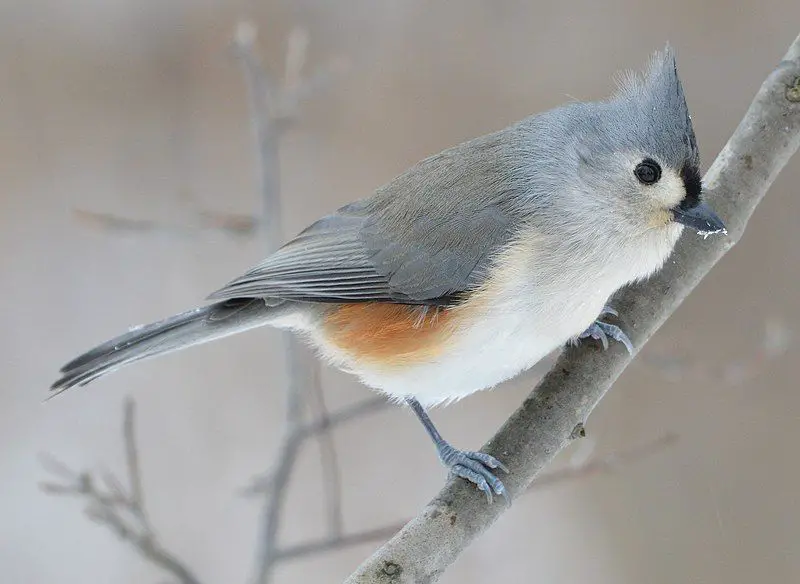
The tufted titmouse is a little bird that can be found in North America. It belongs to the tit and chickadee family, which means it is closely related to other birds in that family.
In the past, there was another bird called the black-crested titmouse that was thought to be a subspecies of the tufted titmouse. This means that they were very similar in appearance and behavior, but had some slight differences.
However, scientists have now determined that the black-crested titmouse is a separate species. It is officially called Baeolophus atricristatus. The black-crested titmouse is found in central and southern Texas, and it extends southward from there.
This means that it can be seen in areas further south from Texas as well. This separation of the black-crested titmouse from the tufted titmouse is an important distinction in the scientific world.
It helps us understand the diversity of bird species and how they are related to each other. It is fascinating to learn about these small songbirds and the distinctions between different species.
By studying and understanding these differences, scientists can gain valuable insights into the natural world and the incredible.
| Kingdom | Animalia |
| Phylum | Chordata |
| Clade | Dinosauria |
| Class | Aves |
| Order | Passeriformes |
| Family | Paridae |
| Genus | Baeolophus |
| Species | B. bicolor |
10. Evening Grosbeak
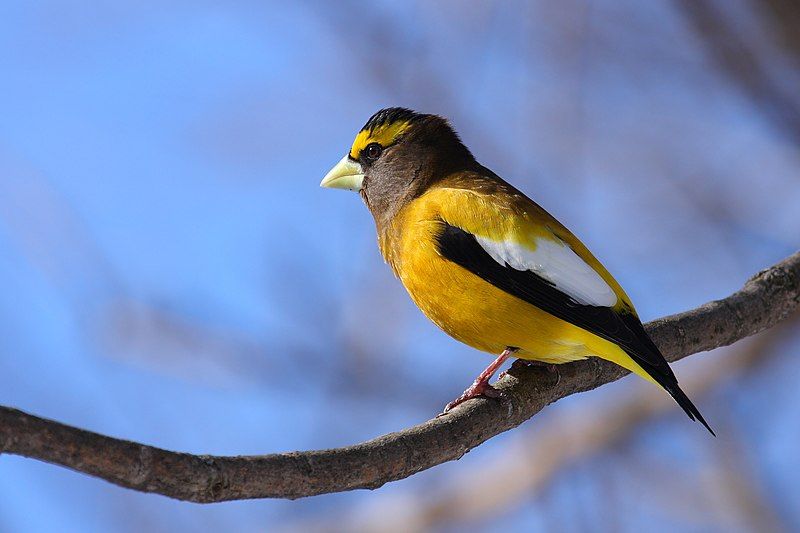
The evening grosbeak is a type of bird that belongs to the finch family and is found in North America. It is known for its bulky body, large bill, and short tail. Scientists have classified it under the genus Hesperiphona.
| Kingdom | Animalia |
| Phylum | Chordata |
| Clade | Dinosauria |
| Class | Aves |
| Order | Passeriformes |
| Family | Fringillidae |
| Genus | Hesperiphona |
| Species | H. vespertina |
11. Common Starling
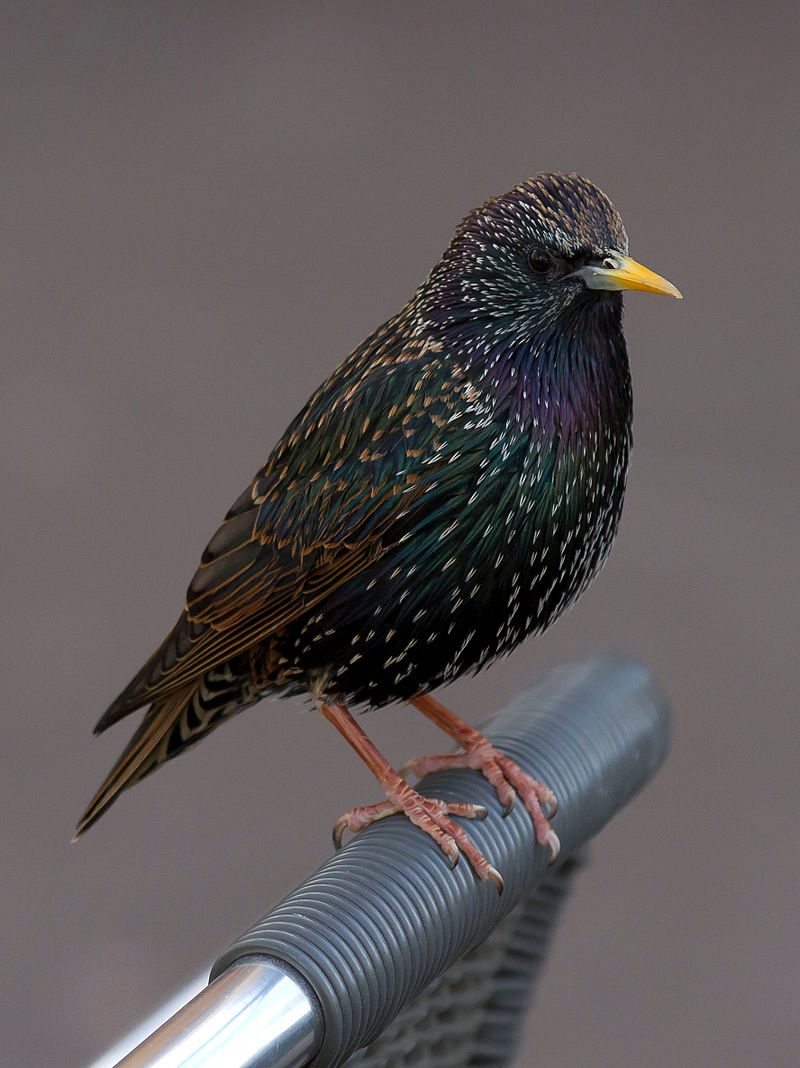
The common starling is a type of bird that can be found in various regions. Depending on the location, it is referred to by different names. In North America, it is known as the European starling, while in Great Britain and Ireland, it is simply called the starling.
This bird belongs to the starling family, scientifically known as Sturnidae. With its medium-sized build, the common starling is classified as a passerine bird. Passerine birds are characterized by having feet adapted for perching, and they make up the largest order of birds.
The starling family, to which the common starling belongs, is known for its diverse species around the world. The common starling is known for its unique features and behaviors. It has a sleek and shiny black plumage with speckled spots, which gives it a distinct appearance.
The bird’s feathers can also appear iridescent in certain lighting conditions, showcasing shades of green and purple. One of the remarkable aspects of the common starling is its ability to mimic sounds and voices.
It has a wide range of vocalizations and can imitate various sounds it hears in its environment, including other bird calls, human speech, and even mechanical noises.
| Kingdom | Animalia |
| Phylum | Chordata |
| Clade | Dinosauria |
| Class | Aves |
| Order | Passeriformes |
| Family | Sturnidae |
| Genus | Sturnus |
| Species | S. vulgaris |
12. Northern Mockingbird
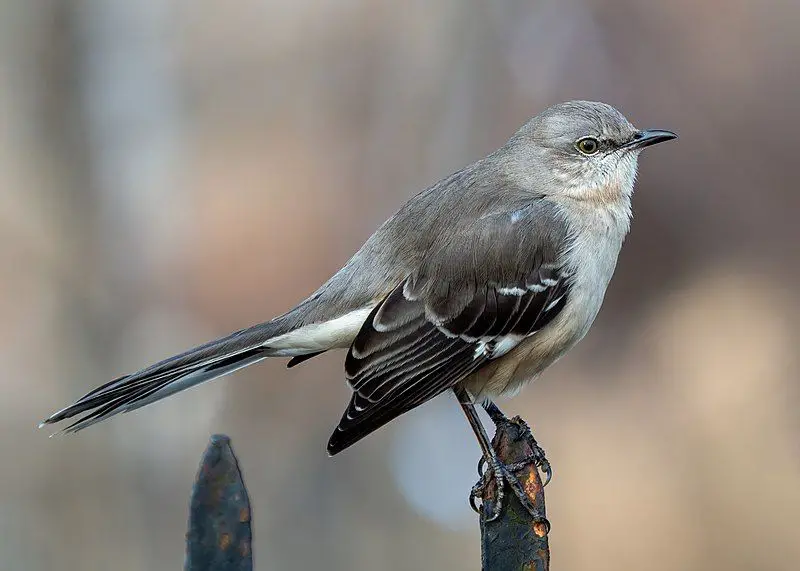
The northern mockingbird is a type of bird that is commonly found in North America. It is known for its ability to mimic the songs of other birds and even sounds from its environment.
This bird is typically seen throughout the year in North America, as it is a permanent resident in the region. However, during periods of extreme weather, such as harsh winters, some northern mockingbirds may decide to migrate south in search of more favorable conditions.
This migration is not common and only occurs when the weather becomes too challenging for these birds to handle. Despite being primarily found in North America, the northern mockingbird has been occasionally observed in Europe.
However, such sightings are quite rare, and this species is not considered a regular visitor to the European continent. It is interesting to note the adaptability of the northern mockingbird in terms of its ability to survive in different environments.
While it is mainly found in North America, it can move to more suitable locations during times of adversity. The northern mockingbird’s ability to mimic sounds is a unique characteristic that sets it apart from other bird species.
This skill allows it to imitate the songs of various birds, as well as sounds like car alarms, sirens, or even human speech.
| Kingdom | Animalia |
| Phylum | Chordata |
| Clade | Dinosauria |
| Class | Aves |
| Order | Passeriformes |
| Family | Mimidae |
| Genus | Mimus |
| Species | M. polyglottos |
13. Downy Woodpecker
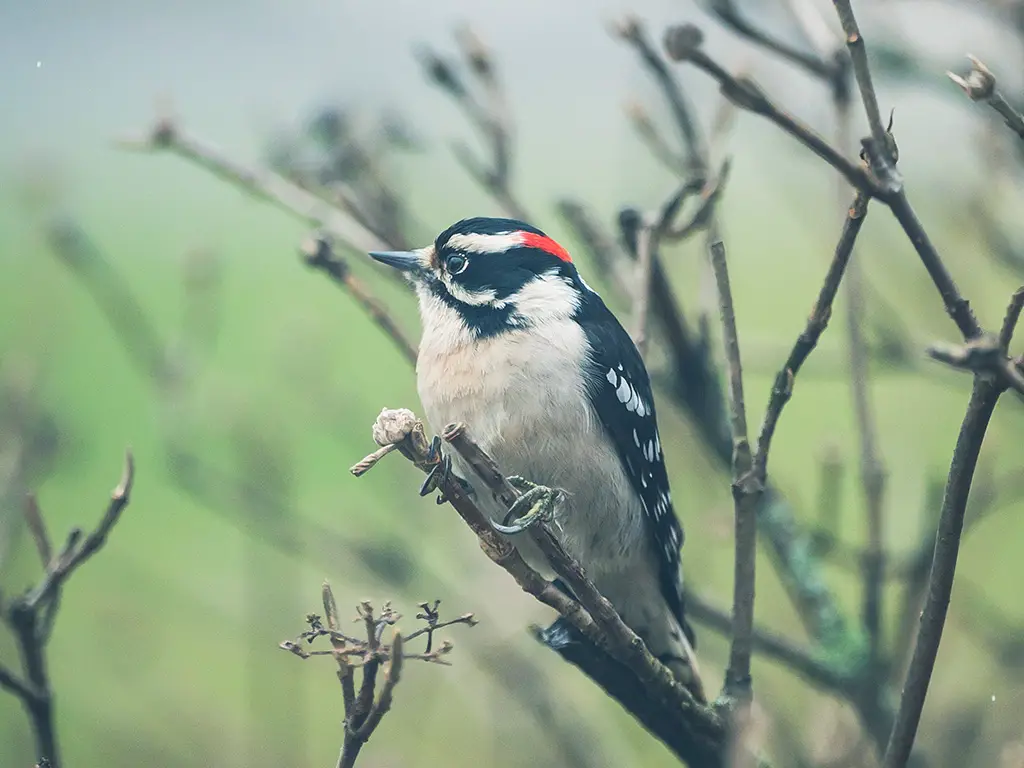
The downy woodpecker is a type of bird known as a woodpecker. It is the smallest species of woodpecker found in North America. Its size can range from 14 to 18 centimeters. These woodpeckers can be found in various forested areas across the United States and Canada.
However, they are not commonly seen in desert regions in the southwest or in the northern tundra. Due to their small size, downy woodpeckers are well-adapted to living in forested environments.
They are able to navigate through the trees and search for food more easily than larger woodpecker species. One interesting feature of the downy woodpecker is its ability to drum on trees.
This drumming serves multiple purposes, including communication with other woodpeckers and marking its territory. The diet of the downy woodpecker primarily consists of insects and larvae found within the trees.
They use their strong beaks to peck at the bark and wood, uncovering their prey. These woodpeckers are known for their distinct black and white plumage. They have a white belly and back, with black wings and a black head. This coloration helps them blend in with the tree.
| Kingdom | Animalia |
| Phylum | Chordata |
| Clade | Dinosauria |
| Class | Aves |
| Order | Piciformes |
| Family | Picidae |
| Genus | Dryobates |
| Species | D. pubescens |
14. Dark-Eyed Junco
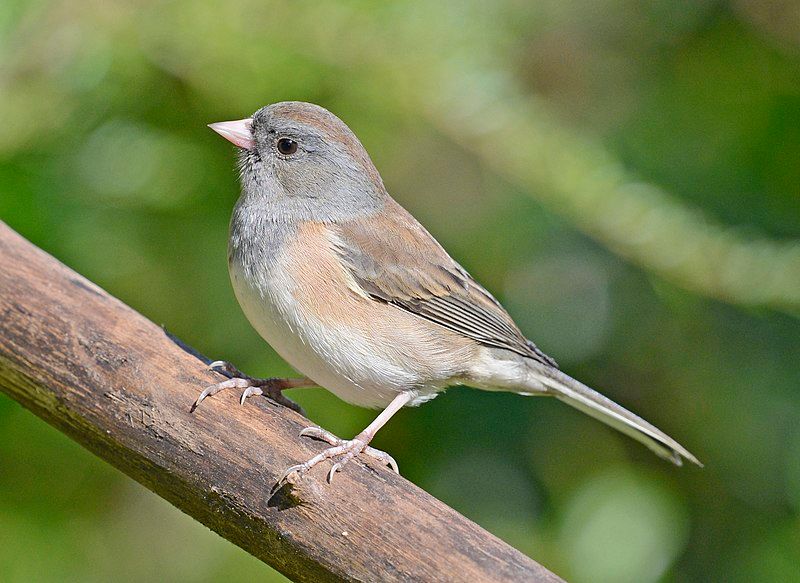
The dark-eyed junco is a type of bird called a junco. Juncos are small, grayish sparrows that live in the New World. The dark-eyed junco is found in many parts of temperate North America, and during the summer, it even goes as far as the Arctic.
The dark-eyed junco is a species that has a lot of variation. This means that different individuals of this bird can look quite different from one another. It is similar to another species of sparrow called the fox sparrow in terms of its variability.
Despite being studied by scientists, the systematics of the dark-eyed junco are still not fully understood. Systematics refers to the study of the relationships between different species and their classification.
So, even though researchers have been trying to figure out how the dark-eyed junco fits into the larger picture of bird species, there are still some unanswered questions.
| Kingdom | Animalia |
| Phylum | Chordata |
| Clade | Dinosauria |
| Class | Aves |
| Order | Passeriformes |
| Family | Passerellidae |
| Genus | Junco |
| Species | J. hyemalis |
15. Song Sparrow
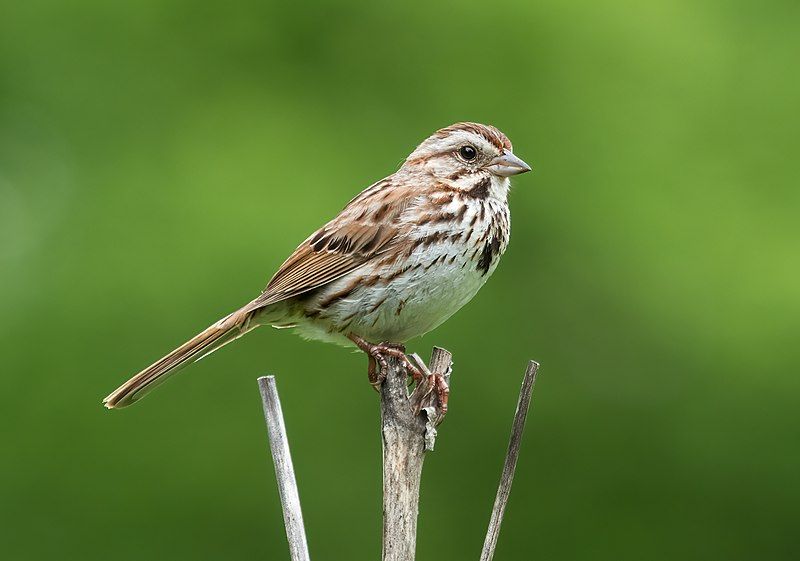
The song sparrow is a type of sparrow that can be found in North America. It is considered to be medium-sized in comparison to other sparrows. Out of all the sparrows native to North America, the song sparrow is known to be one of the most abundant species.
This means that there are a large number of song sparrows in the wild. Not only is the song sparrow abundant, but it is also quite variable. This means that there can be different variations or types of song sparrows. They may have slight differences in appearance or behavior.
In addition to being abundant and variable, the song sparrow is also adaptable. This means that it can adjust well to different environments and conditions. It is able to thrive in various habitats such as grasslands, marshes, and even urban areas.
The adaptability of the song sparrow allows it to have a wide range of distribution. It can be found in many parts of North America, from Canada down to Mexico. Overall, the song sparrow is a fascinating bird that is medium-sized, abundant, variable, and adaptable.
Its ability to adapt to different environments has contributed to its success as a species in North America.
| Kingdom | Animalia |
| Phylum | Chordata |
| Clade | Dinosauria |
| Class | Aves |
| Order | Passeriformes |
| Family | Passerellidae |
| Genus | Melospiza |
| Species | M. melodia |
16. Pine Siskin
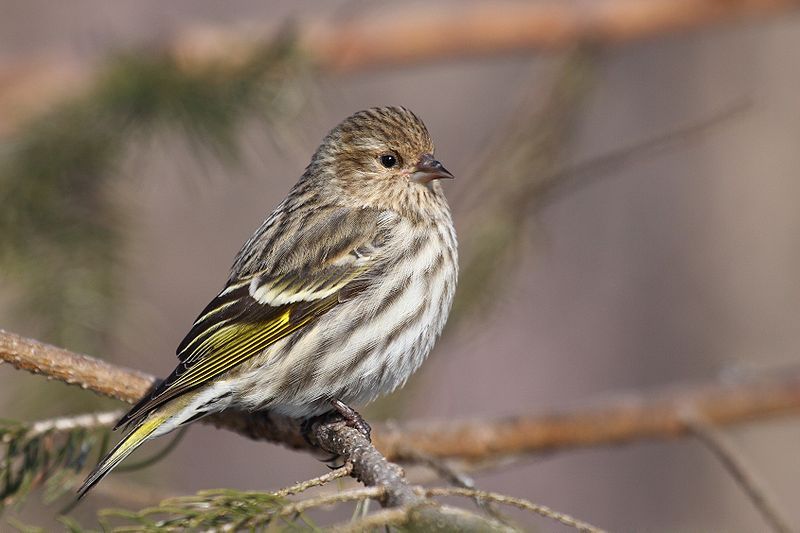
The pine siskin is a type of bird that can be found in North America. It belongs to the finch family, which includes other small birds like sparrows and goldfinches.
The pine siskin is known for its ability to migrate, meaning it travels from one place to another depending on the season. During the winter, the pine siskin’s range becomes very unpredictable.
Instead of following a specific pattern or staying in one place, it moves around sporadically.
This means that it can be difficult to predict where exactly these birds will be during the winter months. The reason behind the pine siskin’s sporadic winter range is not completely understood.
It is believed that factors like food availability and weather conditions play a role in determining their movements.
When certain food sources become scarce in one area, the birds may move to another location in search of better resources. The pine siskin’s winter range can vary from year to year.
One winter, they might be seen in large numbers in a particular region, while the next winter they may be scarce or absent from the same area.
This unpredictability adds to the bird’s unique characteristics and makes it an interesting species to study. Researchers and bird enthusiasts often.
| Kingdom | Animalia |
| Phylum | Chordata |
| Clade | Dinosauria |
| Class | Aves |
| Order | Passeriformes |
| Family | Fringillidae |
| Genus | Spinus |
| Species | S. pinus |
17. Brown-Headed Nuthatch
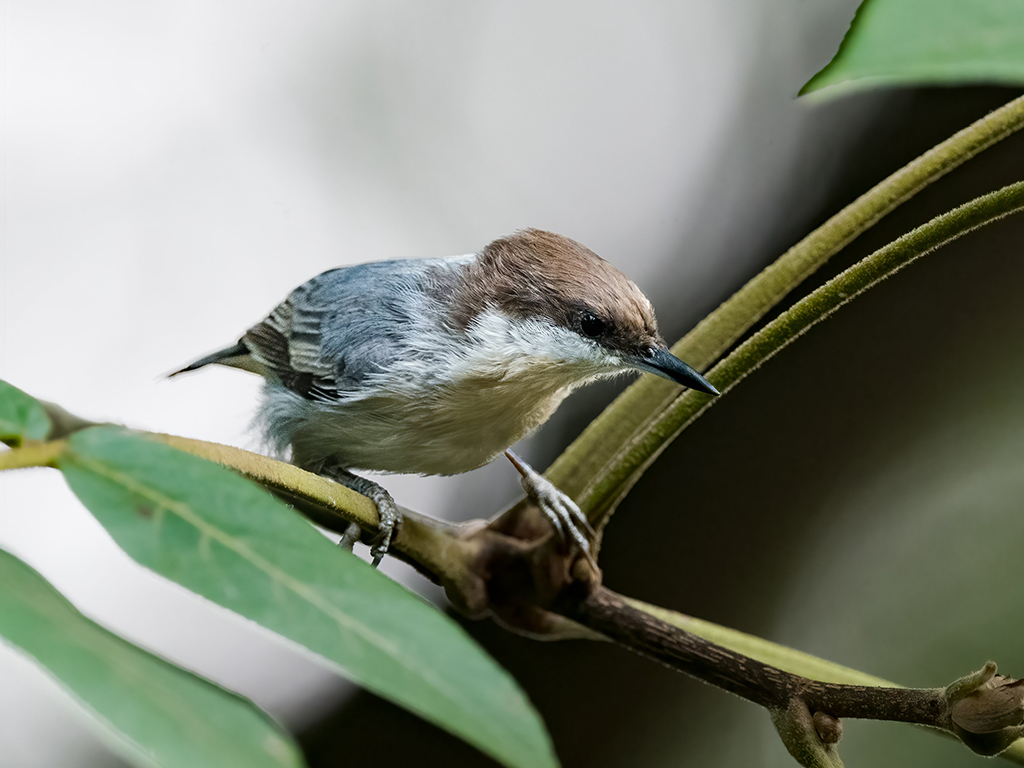
The brown-headed nuthatch is a type of bird. It is known for its small size and can be found in pine forests. This bird is only found in the Southeastern part of the United States. The brown-headed nuthatch has a distinct feature – a brown head.
This feature makes it easy to identify this bird. The nuthatch is not a very large bird, but rather small in size. This species of bird is unique because it is only found in pine forests.
It prefers this type of habitat and can be seen fluttering around the trees in these forests. The brown-headed nuthatch is considered endemic to the Southeastern United States. This means that it is found exclusively in this region and is not found anywhere else in the world.
The nuthatch is also known for its song. It has a melodious chirp that can be heard in the pine forests it inhabits. This song is a way for the bird to communicate with other nuthatches and establish its territory.
The pine forests provide an ideal environment for the brown-headed nuthatch. These birds rely on the trees for nesting and foraging for food. They can often be seen climbing up and down the trunks.
| Kingdom | Animalia |
| Phylum | Chordata |
| Clade | Dinosauria |
| Class | Aves |
| Order | Passeriformes |
| Family | Sittidae |
| Genus | Sitta |
| Species | S. pusilla |
18. Blue Jay
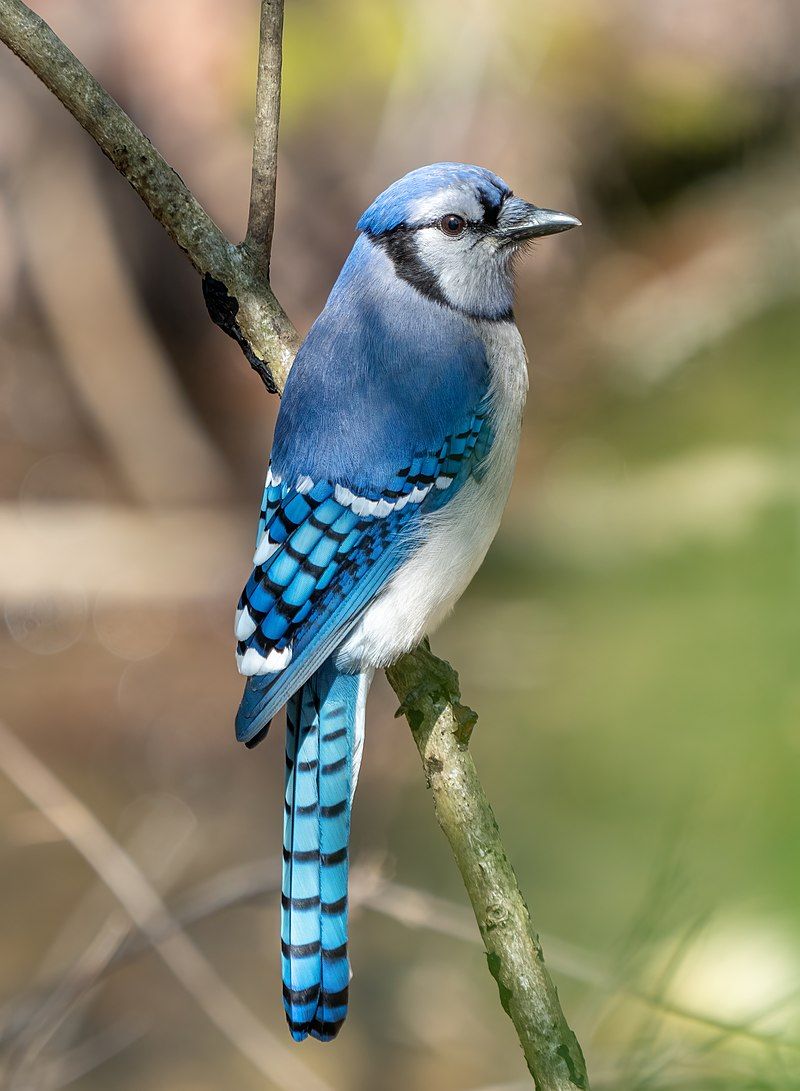
The blue jay is a type of bird that belongs to the family Corvidae. It can be found in eastern North America. This bird is commonly found in many parts of the eastern and central United States.
However, it is important to note that some blue jays in the eastern regions may migrate to other areas. In addition to the United States, blue jays also reside in Newfoundland, Canada. They are considered residents in this area.
Breeding populations of blue jays can be observed across southern Canada. This means that these birds reproduce and raise their young in this region. Overall, the blue jay is a passerine bird, meaning it has specialized feet that allow it to perch on tree branches.
It is native to eastern North America and can be found in various parts of the United States, as well as Newfoundland and southern Canada.
| Kingdom | Animalia |
| Phylum | Chordata |
| Clade | Dinosauria |
| Class | Aves |
| Order | Passeriformes |
| Family | Corvidae |
| Genus | Cyanocitta |
| Species | C. cristata |
19. Red-Breasted Nuthatch
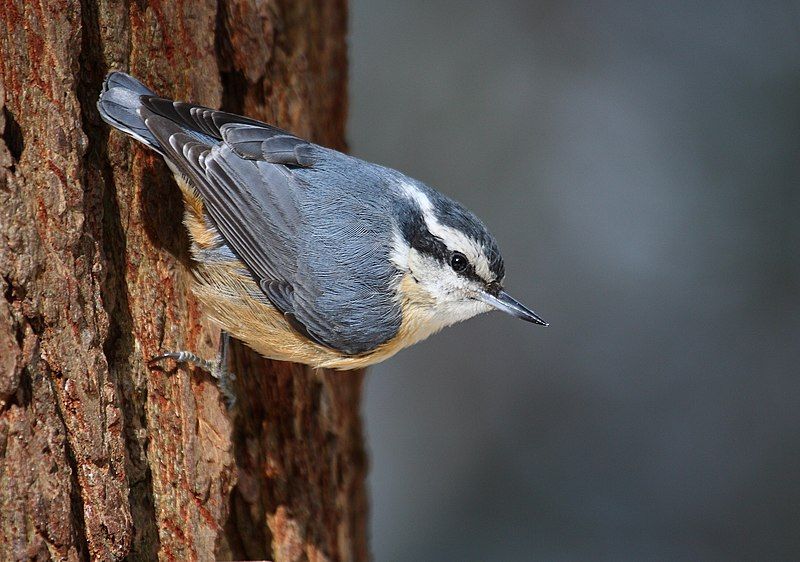
The red-breasted nuthatch is a small bird that is known for its beautiful appearance and unique characteristics. It has blue-grey feathers on its upper body and cinnamon-colored feathers on its underparts.
This combination of colors creates a striking contrast. When you look closely at the red-breasted nuthatch, you will notice a white throat and face. These white areas provide a stark contrast against the rest of its body.
Additionally, there is a distinct black stripe that runs through its eyes, giving it a charming and distinctive look. Another notable feature of the red-breasted nuthatch is its straight grey bill.
This bill is perfectly shaped for its feeding habits and allows it to easily crack open seeds and nuts. The bird’s bill is not only functional but also adds to its overall appearance. One of the most striking features of the red-breasted nuthatch is its black crown.
This black area on top of its head gives the bird a regal and elegant look. When combined with its blue-grey and cinnamon colors, the black crown adds a touch of sophistication to its appearance. Apart from its visual characteristics, the red-breasted nuthatch has a unique call.
Described as a tin trumpet, its call is high-pitched.
| Kingdom | Animalia |
| Phylum | Chordata |
| Clade | Dinosauria |
| Class | Aves |
| Order | Passeriformes |
| Family | Sittidae |
| Genus | Sitta |
| Species | S. canadensis |
20. Hermit Thrush
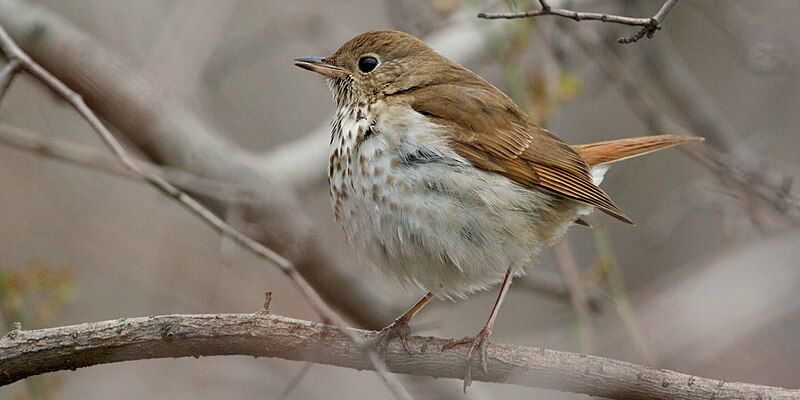
The hermit thrush is a type of bird that can be found in North America. It is considered to be a medium-sized bird.
Interestingly, despite being a North American species, the hermit thrush is not closely related to some other migratory birds in the area that belong to the Catharus genus. Instead, it is more closely related to a bird called the Mexican russet nightingale-thrush.
The hermit thrush is known for its specific name, which is “guttatus.” This name comes from the Latin language and means “spotted.” This is because the bird has spots on its body, which is a distinguishing characteristic.
In summary, the hermit thrush is a medium-sized bird found in North America. It is not closely related to other North American migrant species of the Catharus genus, but rather to the Mexican russet nightingale-thrush.
Its specific name, guttatus, means “spotted” in Latin, referring to the spots on its body.
| Kingdom | Animalia |
| Phylum | Chordata |
| Clade | Dinosauria |
| Class | Aves |
| Order | Passeriformes |
| Family | Turdidae |
| Genus | Catharus |
| Species | C. guttatus |
21. Carolina Wren
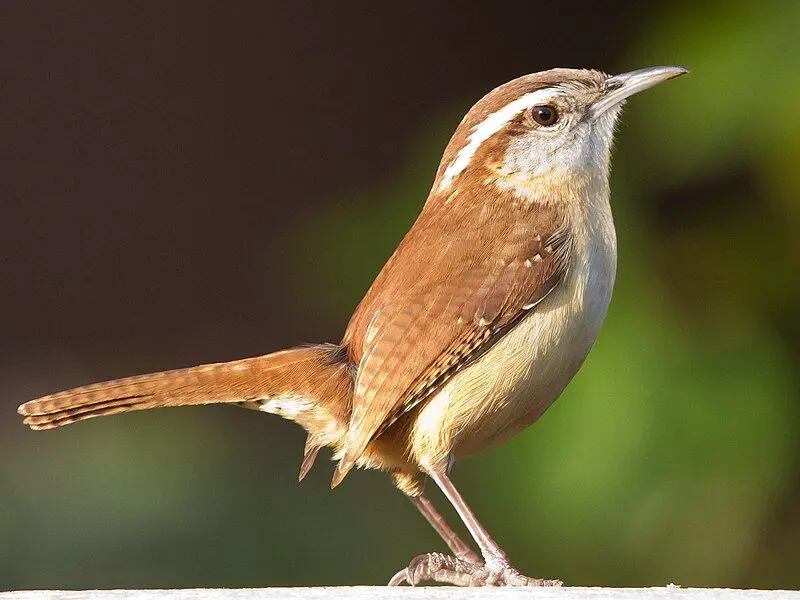
The Carolina wren is a type of wren bird that can be found in several regions. It is considered a common species, meaning it is frequently seen in these areas. The bird is mainly found in the eastern half of the United States of America.
This includes states like North Carolina, South Carolina, and Virginia. However, it can also be spotted in other states within this region. Apart from the United States, the Carolina wren is also seen in certain parts of Canada.
Specifically, it can be found in the extreme south of Ontario. This means that it is only present in the southernmost part of the province.
This is interesting because the bird’s range extends beyond the borders of the United States. Additionally, the Carolina wren can be observed in the extreme northeast of Mexico.
This means that it is found in the northeastern part of the country, close to the border it shares with the United States.
This further highlights the bird’s ability to inhabit different regions within North America. Overall, the Carolina wren is a resident bird in the eastern half of the United States, the extreme south of Ontario, Canada, and the extreme northeast of Mexico.
It is a common species, often seen in these areas. Its range includes several states.
| Kingdom | Animalia |
| Phylum | Chordata |
| Clade | Dinosauria |
| Class | Aves |
| Order | Passeriformes |
| Family | Troglodytidae |
| Genus | Thryothorus |
| Species | T. ludovicianus |
22. Carolina Chickadee
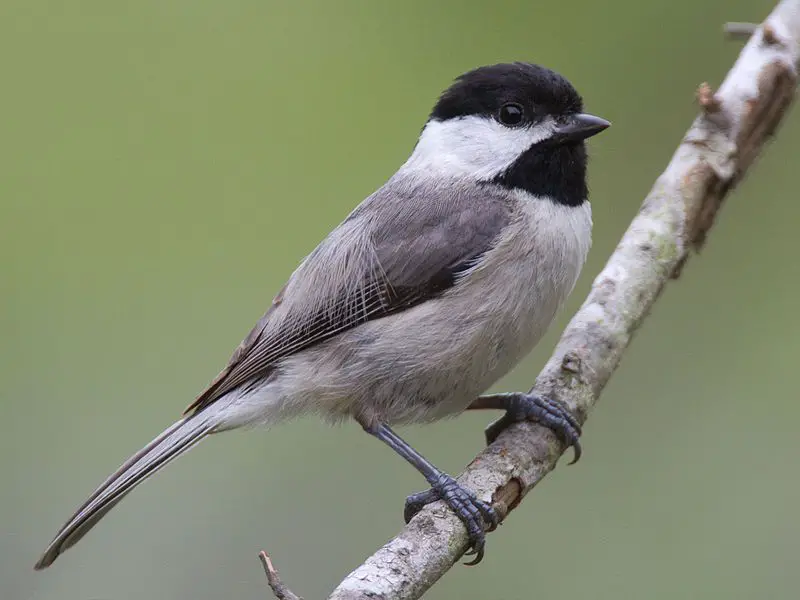
The Carolina chickadee is a type of bird that belongs to the passerine bird family, known as Paridae. It is a small bird that is often seen in North America.
The passerine bird family includes other birds like tits, which are known for their small size and agile nature. Carolina chickadees are known for their distinct appearance and behavior. They have a round body shape with a short neck and a small beak.
Their feathers are mostly gray on the upperparts and white on the underparts, with black and white markings on their wings and tails.
This coloration helps them blend in with their surroundings and provides camouflage for protection. These birds are often found in deciduous and mixed forests, as well as residential areas with trees and shrubs.
They prefer habitats with a variety of vegetation, including both coniferous and deciduous trees.
They are also known to visit bird feeders in people’s yards, especially during the winter months, when food is scarce. Carolina chickadees are social birds and are often seen in small flocks.
They communicate with each other through a variety of vocalizations, including their well-known “chick-a-dee-dee-dee” call.
| Kingdom | Animalia |
| Phylum | Chordata |
| Clade | Dinosauria |
| Class | Aves |
| Order | Passeriformes |
| Family | Paridae |
| Genus | Poecile |
| Species | P. carolinensis |
23. American Crow
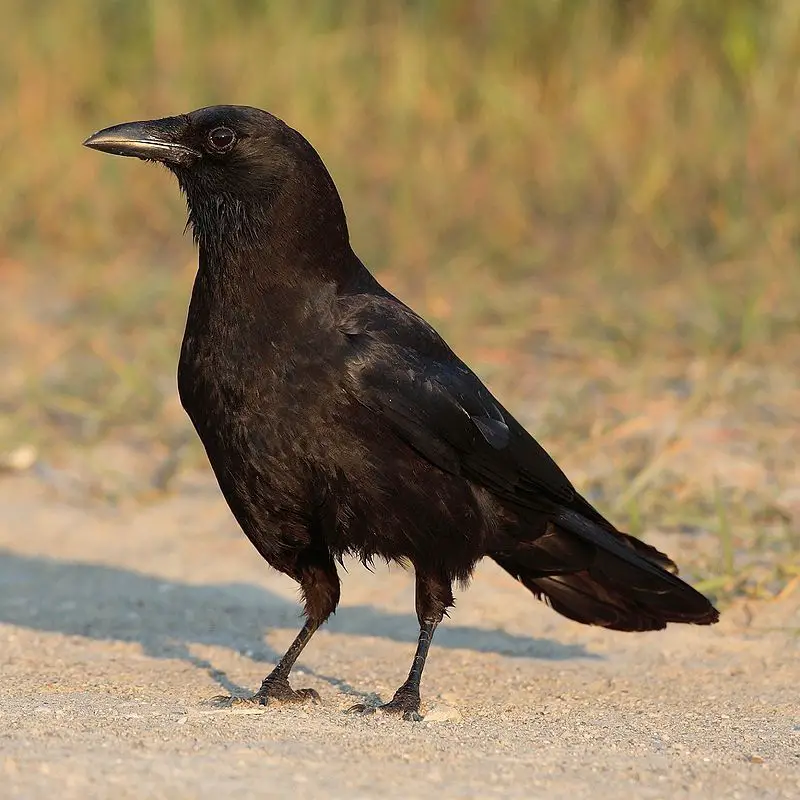
The American crow is a type of bird that belongs to the Corvidae family. This family includes other birds like ravens and jays. The American crow is quite big and is known as a passerine bird, which means it has feet that are adapted for perching on branches.
You can find American crows in many parts of North America. They are a very common bird, so you might have seen them in your own neighborhood. They have adapted well to different environments and can be found in urban areas, forests, and even open fields.
Interestingly, American crows are similar to two other types of crows found in different parts of the world. These are the carrion crow and the hooded crow, which are found in Europe and Asia.
Despite being from different continents, these three crows occupy the same ecological niche. An ecological niche refers to the role a species plays in its environment. In this case, the American crow, carrion crow, and hooded crow all have similar behaviors and habits.
They are opportunistic feeders, meaning they eat a wide range of things like insects, fruits, small animals, and even garbage. They also play important roles in controlling populations of certain pests and scaveng.
| Kingdom | Animalia |
| Phylum | Chordata |
| Clade | Dinosauria |
| Class | Aves |
| Order | Passeriformes |
| Family | Corvidae |
| Genus | Corvus |
| Species | C. brachyrhynchos |
24. Pileated Woodpecker
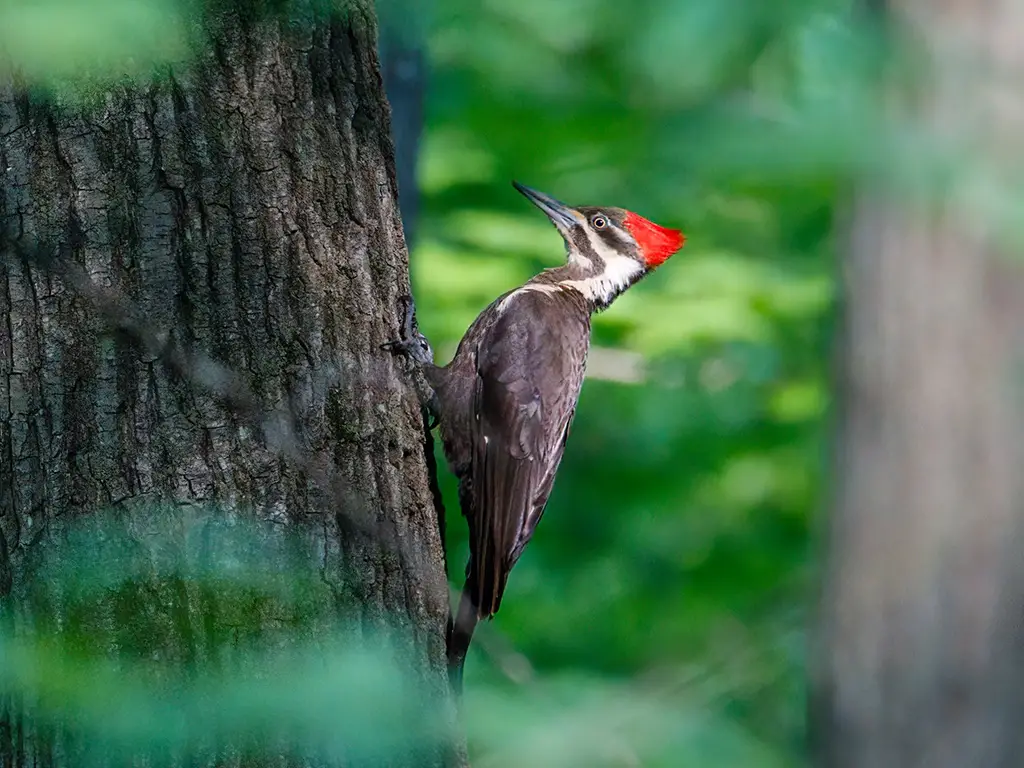
The pileated woodpecker is a type of bird that is mostly black and is found in North America. It is a relatively large bird compared to other woodpeckers. The pileated woodpecker mostly eats insects, which makes it an insectivore.
It usually lives in deciduous forests located in eastern North America. In addition to the eastern part of North America, the pileated woodpecker can also be found in the Great Lakes region. This means it can be seen in areas like Michigan, Minnesota, and the surrounding states.
The bird is also found in the boreal forests of Canada. These forests are characterized by mostly coniferous trees and are located in the northern parts of Canada. Furthermore, the pileated woodpecker can be spotted in certain areas along the Pacific Coast.
This means it can be found in states like Oregon and Washington. It is interesting to note that the bird’s habitat spans across different regions, showing its adaptability to various environments.
Overall, the pileated woodpecker is a fascinating bird that is native to North America. Its black feathers and relatively large size make it easy to identify. It prefers to live in deciduous forests.
| Kingdom | Animalia |
| Phylum | Chordata |
| Clade | Dinosauria |
| Class | Aves |
| Order | Piciformes |
| Family | Picidae |
| Genus | Dryocopus |
| Species | D. pileatus |
25. Red-Winged Blackbird
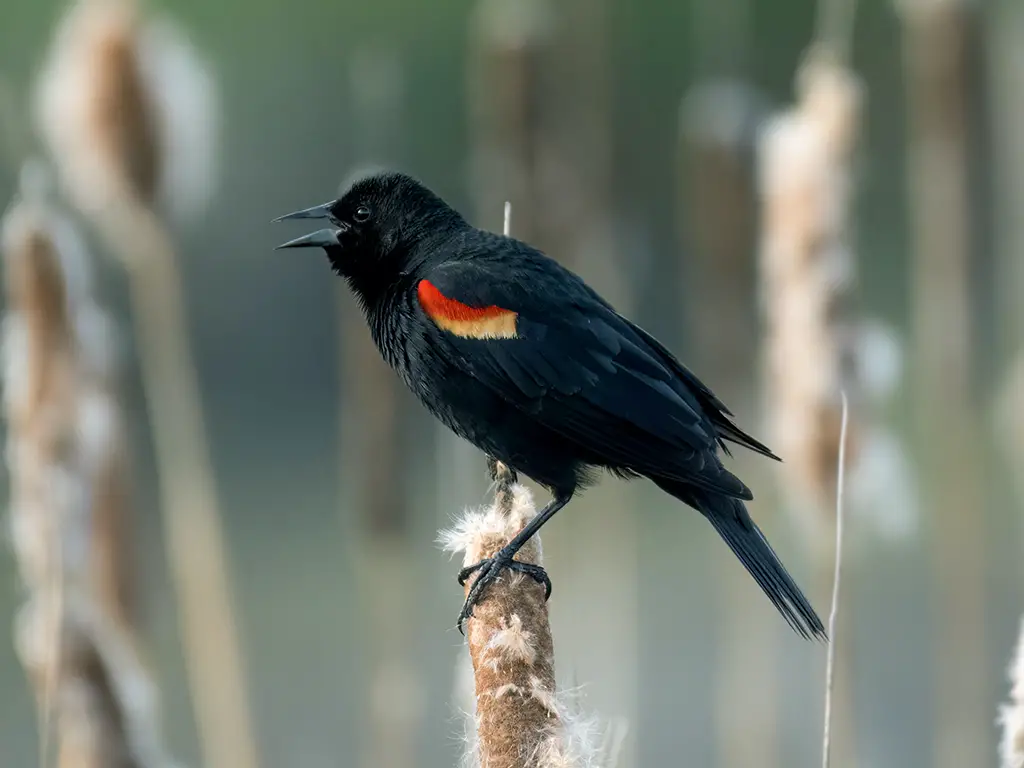
The red-winged blackbird is a type of bird that belongs to the passerine family called Icteridae.
It is commonly found in various parts of North America and a significant portion of Central America. Passerines are a diverse group of birds that are known for their musical and complex songs.
They have specialized vocal organs that allow them to produce a wide range of sounds. The red-winged blackbird is easily recognizable due to its distinct appearance.
The male red-winged blackbird has glossy black plumage and bright red patches on its wings, which give it its name.
On the other hand, the female red-winged blackbird has a more subdued appearance with brown feathers and streaks. These birds have a unique habitat preference, as they are commonly found in wetlands, marshes, and areas with tall grasses.
They are skilled at perching on tall plants and reeds, where they can easily spot their prey and potential predators. Red-winged blackbirds primarily feed on insects, seeds, and grains. They use their sharp beaks to catch insects on the fly and extract seeds from plants.
During the breeding season, they may also consume small vertebrates such as frogs and tadpoles.
| Kingdom | Animalia |
| Phylum | Chordata |
| Clade | Dinosauria |
| Class | Aves |
| Order | Passeriformes |
| Family | Icteridae |
| Genus | Agelaius |
| Species | A. phoeniceus |
26. Common Grackle
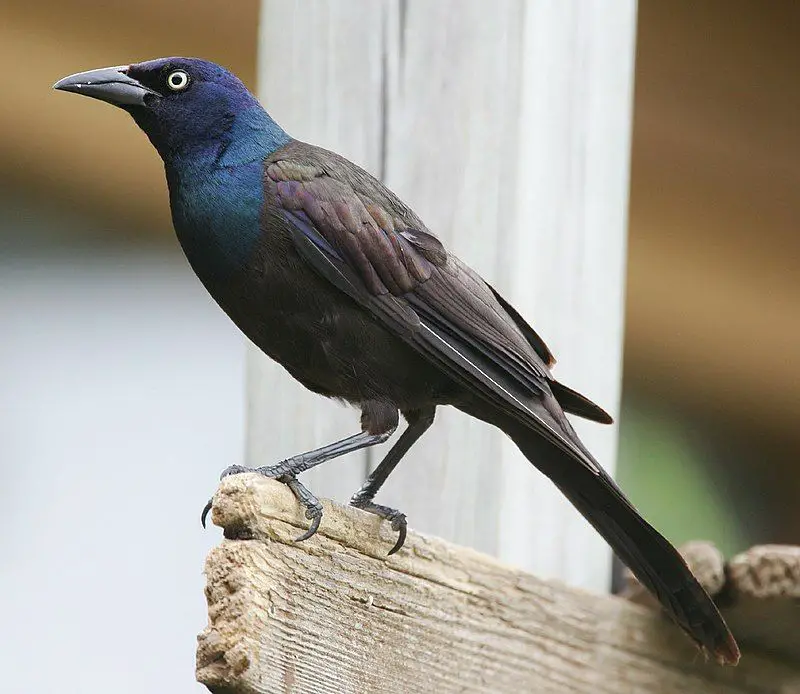
The common grackle is a type of bird that can be found in many parts of North America. It was first identified and described by a scientist named Carl Linnaeus in the year 1758. This bird belongs to a family of birds known as icterids.
One interesting thing about the common grackle is that it has three different subspecies. This means that there are slight variations in appearance among the different groups of these birds. When an adult common grackle is fully grown, it has certain distinct features.
For example, it has a long bill that is dark in color. This bill is used by the bird to catch and eat its food. The common grackle also has pale yellow eyes, which add to its unique appearance. Another noticeable characteristic of the adult common grackle is its long tail.
This tail is an important part of the bird’s body, as it helps with balance and maneuverability during flight. It is worth noting that the common grackle is a fairly large bird compared to some other species.
Its size contributes to its visibility and makes it easier to spot in its natural habitat. Overall, the common grackle is an interesting bird species with distinct physical traits. It’s large numbers across North.
| Kingdom | Animalia |
| Phylum | Chordata |
| Clade | Dinosauria |
| Class | Aves |
| Order | Passeriformes |
| Family | Icteridae |
| Genus | Quiscalus |
| Species | Q. quiscula |
27. Broad-Winged Hawk

The broad-winged hawk is a type of hawk that is medium in size. It belongs to the genus Buteo. Some subspecies of this hawk are found in eastern North America during the summer. These subspecies can be found as far west as British Columbia and Texas.
However, when the winter season arrives, these hawks migrate to the Neotropics. The Neotropics is a region that extends from Mexico to southern Brazil. During the summer, the broad-winged hawk can be seen in various parts of eastern North America.
This includes areas as far west as British Columbia and Texas. These hawks prefer to reside in this region during the warmer months. They build their nests and raise their young in these areas.
However, when the temperature starts to drop and the winter season approaches, the broad-winged hawks begin their migration. They leave their summer homes in eastern North America and travel towards the Neotropics.
The Neotropics provide a more suitable environment for them during the colder months. The migration of these hawks takes them on a long journey. They fly southwards from their breeding grounds, crossing vast distances.
They travel through different regions, adapting to changing landscapes and weather conditions.
| Kingdom | Animalia |
| Phylum | Chordata |
| Clade | Dinosauria |
| Class | Aves |
| Order | Accipitriformes |
| Family | Accipitridae |
| Genus | Buteo |
| Species | B. platypterus |
28. Eastern Towhee
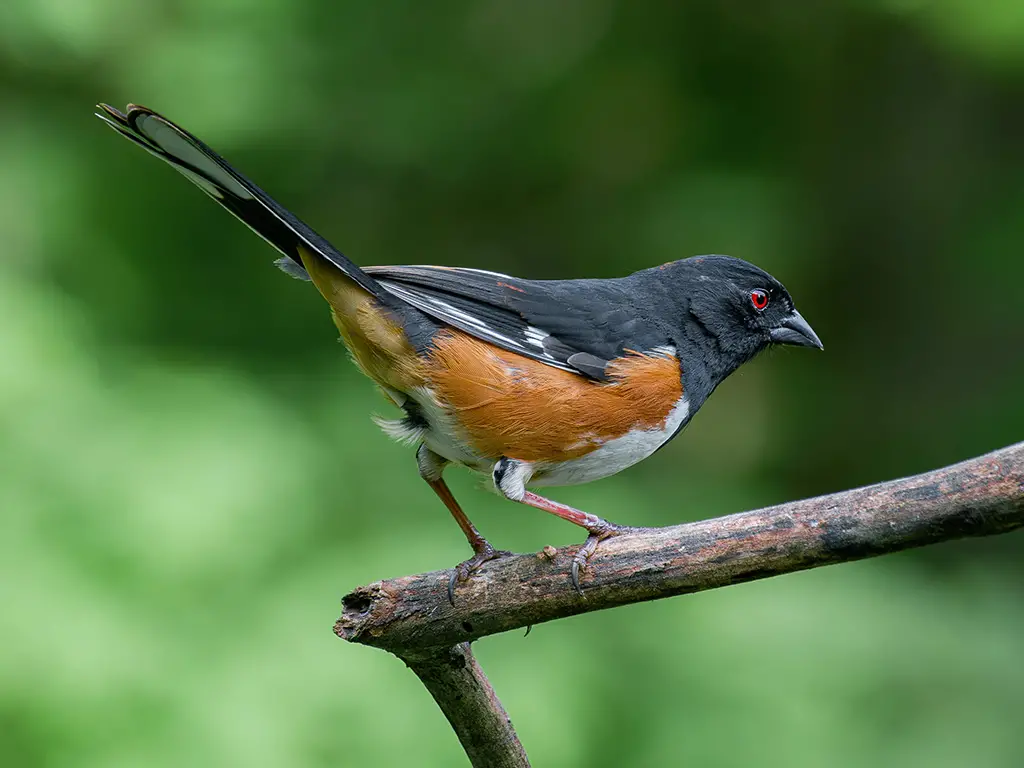
The eastern towhee is a type of sparrow that is found in the New World. It is a relatively large sparrow compared to other species. However, there has been some disagreement among scientists about the classification of towhees in recent years.
In the past, the eastern towhee and the spotted towhee were thought to be the same species called the rufous-sided towhee. The debate about the taxonomy of towhees has caused confusion and uncertainty among experts.
They have been trying to determine the exact relationship between the eastern towhee and the spotted towhee.
This has led to discussions and research to better understand the differences and similarities between these two birds. Despite the taxonomic debate, it is agreed that the eastern towhee has a specific breeding habitat in brushy areas across eastern North America.
This means that they prefer to build their nests and raise their young in areas that are filled with dense vegetation and shrubs. The brushy areas provide the eastern towhees with the necessary cover and protection for their breeding activities.
These habitats are abundant in eastern North America, making it an ideal place for the eastern towhee to thrive and reproduce. By studying the breeding habitats of the eastern towhee.
| Kingdom | Animalia |
| Phylum | Chordata |
| Clade | Dinosauria |
| Class | Aves |
| Order | Passeriformes |
| Family | Passerellidae |
| Genus | Pipilo |
| Species | P. erythrophthalmus |
29. White-Breasted Nuthatch
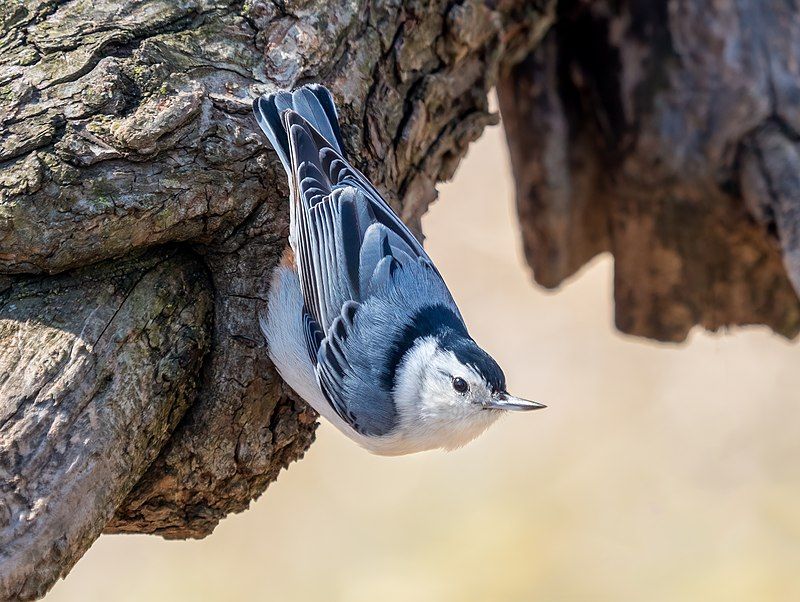
The white-breasted nuthatch is a type of bird that belongs to the nuthatch family called Sittidae.
This family includes various species of nuthatches, but we will focus on the white-breasted nuthatch in this discussion. The white-breasted nuthatch is considered to be a medium-sized bird, measuring around 15.5 cm in length.
This measurement gives us an idea of its size in comparison to other birds. While it may not be the largest bird out there, it is also not the smallest. One interesting feature of the white-breasted nuthatch is its white breast, which gives it its name.
This white coloration on its chest stands out and helps to identify it from other species of nuthatches.
It is worth noting that not all nuthatches have this specific feature, making it unique to the white-breasted nuthatch. Being a member of the nuthatch family, the white-breasted nuthatch shares certain characteristics with other nuthatch species.
For example, nuthatches are known for their ability to climb up and down trees headfirst. This behavior is quite fascinating to observe, as most birds can only move in an upward direction.
| Kingdom | Animalia |
| Phylum | Chordata |
| Clade | Dinosauria |
| Class | Aves |
| Order | Passeriformes |
| Family | Sittidae |
| Genus | Sitta |
| Species | S. carolinensis |
30. Great Blue Heron

The great blue heron is a type of bird that belongs to the heron family called Ardeidae. It is a big bird that is often seen wading in water. You can find it near the shores of open water and in wetlands in many parts of North and Central America.
It is also found in far northwestern South America, the Caribbean, and even the Galápagos Islands. These herons are known for their tall and slender bodies, with long legs and a long neck.
They have a distinctive blue-gray coloration on their feathers, which gives them their name.
They also have a large, dagger-like beak that they use to catch their prey. You can often spot great blue herons standing still in shallow water, patiently waiting for fish or other small animals to come by.
They are excellent hunters and have sharp eyesight, which helps them spot their prey from a distance.
Once they see a potential meal, they use their long necks to strike quickly and snatch it up with their beaks. While they primarily feed on fish, these herons are also known to eat amphibians, reptiles, and even small mammals.
Their diet depends on what is available in their habitat. They are adaptable.
| Kingdom | Animalia |
| Phylum | Chordata |
| Clade | Dinosauria |
| Class | Aves |
| Order | Pelecaniformes |
| Family | Ardeidae |
| Genus | Ardea |
| Species | A. herodias |
31. Red-Headed Woodpecker
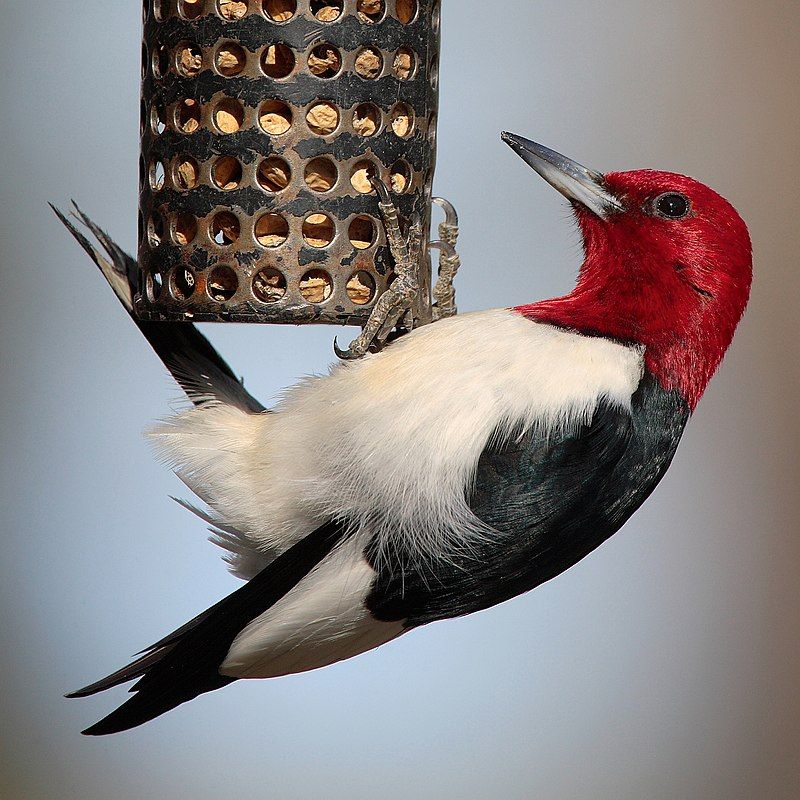
The red-headed woodpecker is a type of woodpecker that can be found in temperate regions of North America. It is not too big or too small, but rather a mid-sized bird. This woodpecker is known for its distinct red head, which sets it apart from other woodpecker species.
Its vibrant red color stands out against its black and white body. In terms of its habitat, the red-headed woodpecker prefers open areas in southern Canada and the east-central United States. It is specifically found in regions with a moderate climate.
During the breeding season, this woodpecker builds its nests in these open country habitats. It looks for suitable spots to create its nest, often choosing dead trees or branches.
The red-headed woodpecker is a skilled excavator, using its strong beak to make holes in the trees for its nests. These holes not only serve as a nesting site but also as a source of food storage.
In addition to nesting, the red-headed woodpecker also searches for food in its breeding habitat. It feeds on a variety of insects, fruits, nuts, and even small vertebrates. This woodpecker is known for its agility and acrobatic.
| Kingdom | Animalia |
| Phylum | Chordata |
| Clade | Dinosauria |
| Class | Aves |
| Order | Piciformes |
| Family | Picidae |
| Genus | Melanerpes |
| Species | M. erythrocephalus |
32. Rufous Hummingbird
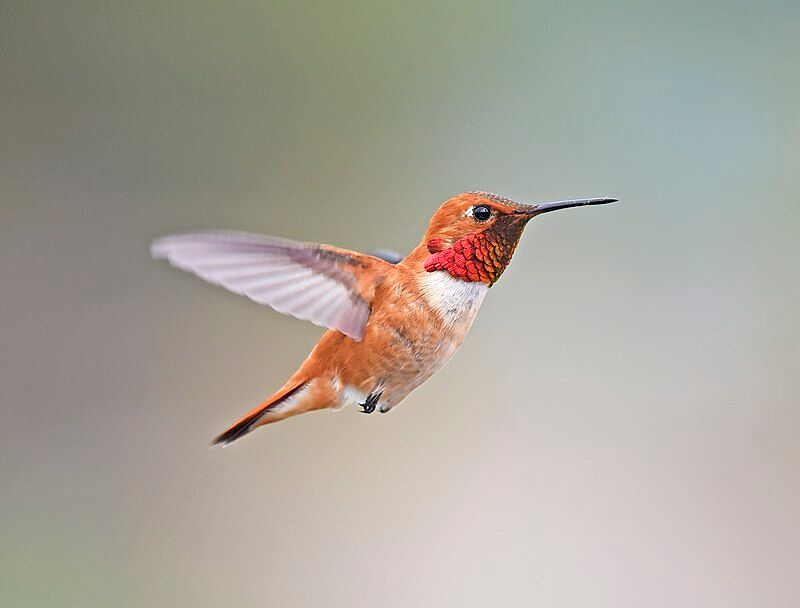
The rufous hummingbird is a tiny bird, measuring only about 8 cm in length. It has a distinctive long, straight, and slender bill, which it uses to feed on nectar from flowers. These birds are renowned for their exceptional flight abilities.
During their migratory journeys, they can cover an astonishing distance of up to 2,000 miles. The rufous hummingbird belongs to a group called the Selasphorus genus, which comprises a total of nine different species.
Each species within this genus shares similar characteristics and features. However, the rufous hummingbird is unique in its way. These birds’ flight skills are truly remarkable.
They are capable of hovering in mid-air, flying forward and backward, and even flying upside down. Their wings beat incredibly fast, allowing them to stay in one place while feeding on nectar.
This agile flight pattern also enables them to catch small insects mid-air, which they supplement their diet with. During their long migratory transits, rufous hummingbirds travel vast distances.
They undertake these journeys in search of suitable breeding grounds and food sources. Despite their small size, these birds possess impressive endurance and determination to reach their destinations.
| Kingdom | Animalia |
| Phylum | Chordata |
| Clade | Strisores |
| Class | Aves |
| Order | Apodiformes |
| Family | Trochilidae |
| Genus | Selasphorus |
| Species | S. rufus |
33. Canada Goose
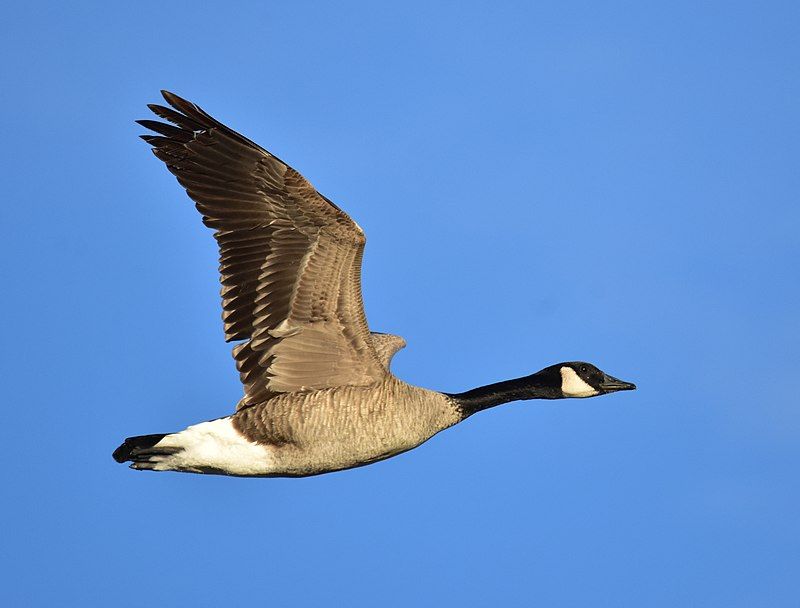
The Canada goose is a type of wild goose that can also be referred to as the Canadian goose. It is quite large and has distinct physical features. One of its notable characteristics is a black head and neck.
Additionally, it has white cheeks and a white area under its chin. The body of the Canada goose is typically brown. This species of goose is originally from the arctic and temperate regions of North America. It is well-adapted to these colder climates.
However, during migration, the Canada goose has been known to travel across the Atlantic and can occasionally be found in northern Europe. The Canada goose is a fascinating bird that has captured the attention of many due to its unique appearance.
Its black head and neck create a striking contrast against its white cheeks and chin.
This distinctive coloration helps to easily identify the Canada goose from other species. Native to the arctic and temperate regions of North America, the Canada goose has evolved to survive in harsh environments.
Its adaptations to cold climates include a sturdy build and insulating feathers.
These features enable the goose to endure freezing temperatures and harsh weather conditions. Although primarily found in North America, the Canada goose displays an interesting behavior during migration.
| Kingdom | Animalia |
| Phylum | Chordata |
| Clade | Dinosauria |
| Class | Aves |
| Order | Anseriformes |
| Family | Anatidae |
| Genus | Branta |
| Species | B. canadensis |
34. Ring-Billed Gull

The ring-billed gull is a type of gull that is medium in size. The term “ring-billed” comes from the distinctive ring-like band around its beak. This gull belongs to a group of birds known as Larus, which is the genus name.
The term “Larus” is derived from Latin and seems to have been used to describe gulls or other large seabirds. The genus name, Larus, is a way to categorize and classify different species of gulls.
It helps scientists and bird enthusiasts understand the relationships and similarities between these birds.
By using the genus name Larus, it becomes easier to identify and study gulls systematically. The specific name of this particular gull, delawarensis, refers to the Delaware River.
This means that the ring-billed gull is somehow associated with or found near the Delaware River.
It is named after this specific location, which may be a significant habitat for this species. The naming of species often involves using specific names that indicate a particular geographic location or characteristic of the species.
In the case of the ring-billed gull, the term delawarensis is used to highlight its connection to the Delaware River.
| Kingdom | Animalia |
| Phylum | Chordata |
| Clade | Dinosauria |
| Class | Aves |
| Order | Charadriiformes |
| Family | Laridae |
| Genus | Larus |
| Species | L. delawarensis |
35. Turkey Vulture
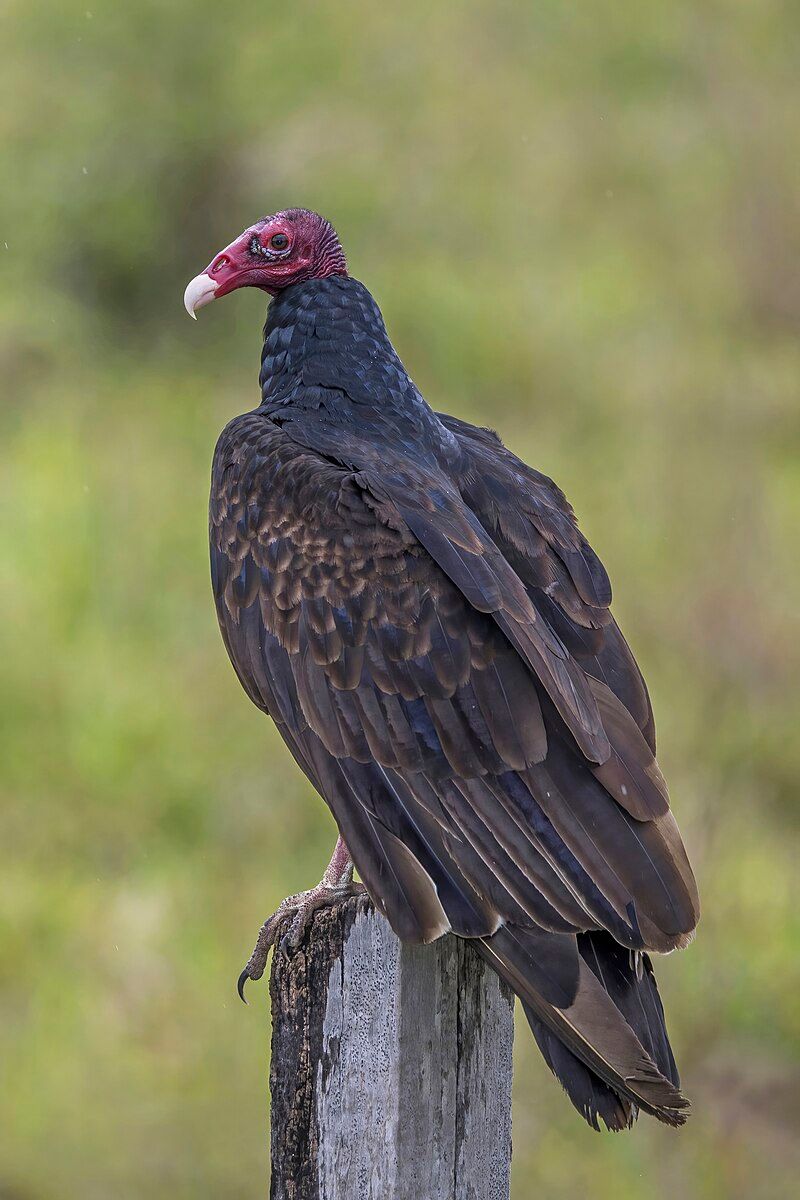
The turkey vulture is a type of vulture that can be found in many different parts of the Americas. It is the most widespread of all the New World vultures. There are three species of vultures in a group called the genus Cathartes.
The turkey vulture is one of these species. It belongs to the family Cathartidae, which is a group of birds that includes vultures. The turkey vulture can be found in a vast range of locations.
It can be seen from southern Canada, all the way down to the very tip of South America. This means that it can be found in many different countries and environments throughout the Americas. This bird has a very large range because it is well adapted to various habitats.
It can thrive in a wide range of conditions and climates. The turkey vulture is known for its characteristic appearance. It has a bald head, which is red. Its body is mostly black or dark brown, and it has long wings and a long tail.
This vulture is a scavenger, which means that it feeds on dead animals. It has a highly developed sense of smell, which allows it to locate carrion from high.
| Kingdom | Animalia |
| Phylum | Chordata |
| Clade | Dinosauria |
| Class | Aves |
| Order | Accipitriformes |
| Family | Cathartidae |
| Genus | Cathartes |
| Species | C. aura |
36. Great Horned Owl
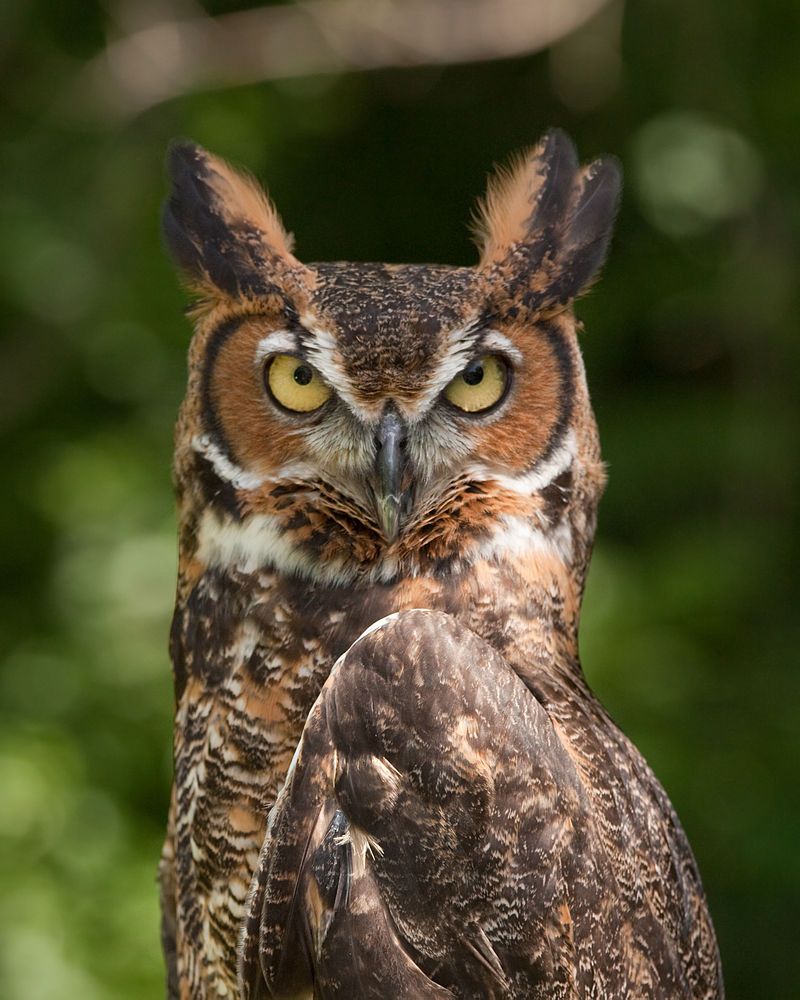
The great horned owl is a species of owl found in the Americas. It is also known by other names such as the tiger owl and the hoot owl.
This owl is known for its adaptability and can be found in various habitats across its wide range. Being a large owl, the great horned owl has a distinct appearance. It has prominent ear tufts on its head, which give it a horned appearance.
This characteristic distinguishes it from other owl species. One of the remarkable traits of the great horned owl is its adaptability. It can be found in a wide range of habitats, including forests, deserts, mountains, and even urban areas.
This versatility allows the owl to thrive in diverse environments and makes it the most widely distributed true owl in the Americas. The great horned owl is a skilled hunter, preying on a variety of animals. Its diet includes small mammals like rabbits, mice, and rats.
Additionally, it feeds on birds, reptiles, amphibians, and even other owls. This owl species has excellent hunting abilities. It possesses sharp talons and a powerful beak, which it uses to catch and kill its prey.
Its wings are designed for silent flight, allowing it to approach.
| Kingdom | Animalia |
| Phylum | Chordata |
| Clade | Dinosauria |
| Class | Aves |
| Order | Strigiformes |
| Family | Strigidae |
| Genus | Bubo |
| Species | B. virginianus |
37. Baltimore Oriole
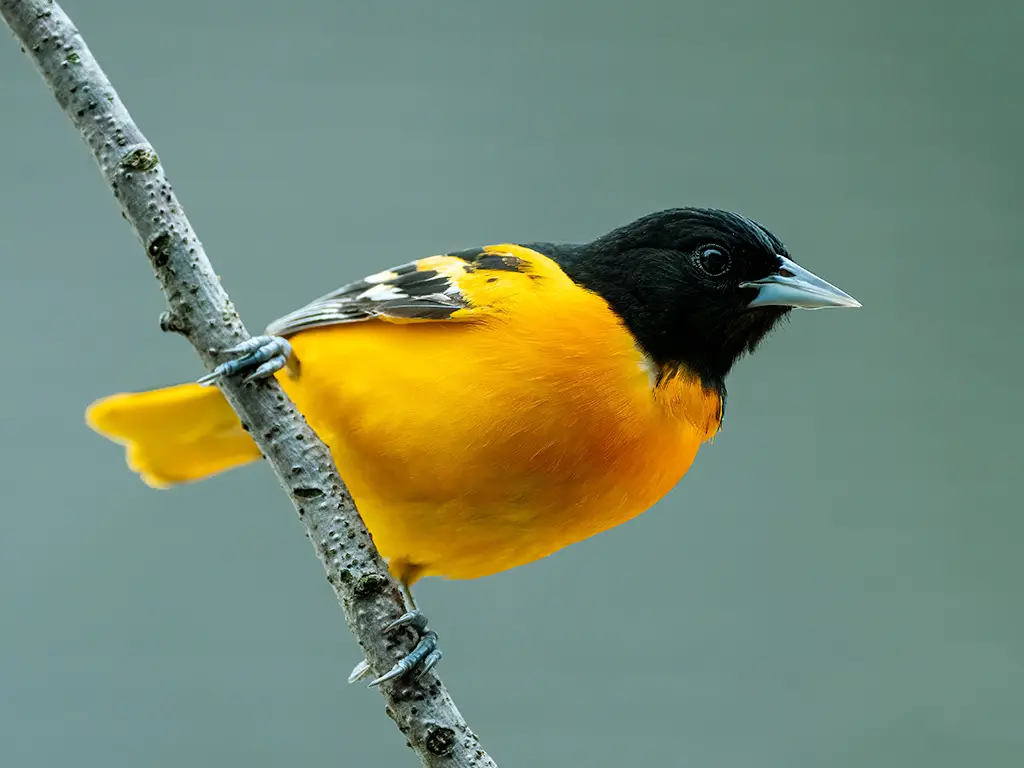
The Baltimore oriole is a type of bird that belongs to the icterid blackbird family. It is found commonly in eastern parts of North America. This bird is known for its tendency to migrate during the breeding season. The reason behind its name is quite fascinating.
It is said that the Baltimore oriole got its name because of the similarity between the male’s colors and the coat-of-arms of Lord Baltimore, who lived in the 17th century.
This suggests that the bird’s vibrant and distinct colors reminded people of the coat-of-arms. The male Baltimore oriole is particularly known for its striking appearance. It has bright orange plumage on its underparts, while its head, back, and wings are black.
The combination of these contrasting colors makes the male Baltimore oriole stand out in its habitat. On the other hand, the female Baltimore oriole has a more subdued appearance. Its plumage is primarily yellowish-brown, which helps it blend in better with its surroundings.
This difference in appearance between males and females is a common characteristic among many bird species. In addition to its striking appearance, the Baltimore oriole is also known for its beautiful song. The male bird sings a complex.
| Kingdom | Animalia |
| Phylum | Chordata |
| Clade | Dinosauria |
| Class | Aves |
| Order | Passeriformes |
| Family | Icteridae |
| Genus | Icterus |
| Species | I. galbula |
38. Yellow-Rumped Warbler
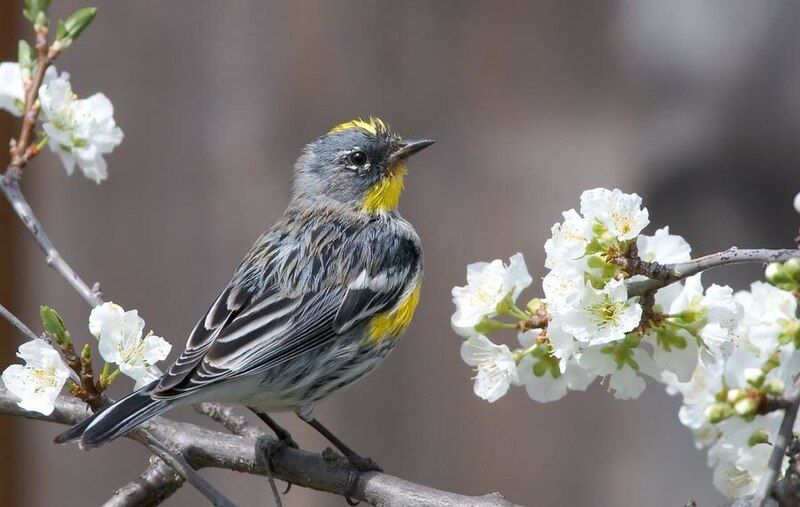
The yellow-rumped warbler is a type of bird that is found in North America. It is quite common and can be seen in many different places across the continent. This bird species is known for its distinct yellow feathers on its rump, or lower back.
This is where it gets its name from. These yellow feathers make it easy to identify the yellow-rumped warbler in the wild. The yellow-rumped warbler is a small bird, measuring around 5 to 6 inches in length. It has a slim body with a pointed beak and long wings.
Its wingspan can reach up to 9 to 10 inches, allowing it to fly swiftly and gracefully. One interesting fact about this bird is that it is known for its ability to migrate long distances. During the breeding season, yellow-rumped warblers can be found in North America.
However, when winter arrives, they migrate south to warmer regions, such as Mexico and Central America. This bird species can be found in a variety of habitats. It is often seen in forests, woodlands, and even urban areas.
It has adapted well to different environments and can thrive in both deciduous and coniferous forests. The yellow-rumped warbler has a diverse.
| Kingdom | Animalia |
| Phylum | Chordata |
| Clade | Dinosauria |
| Class | Aves |
| Order | Passeriformes |
| Family | Parulidae |
| Genus | Setophaga |
| Species | S. coronata |
39. Wood Duck
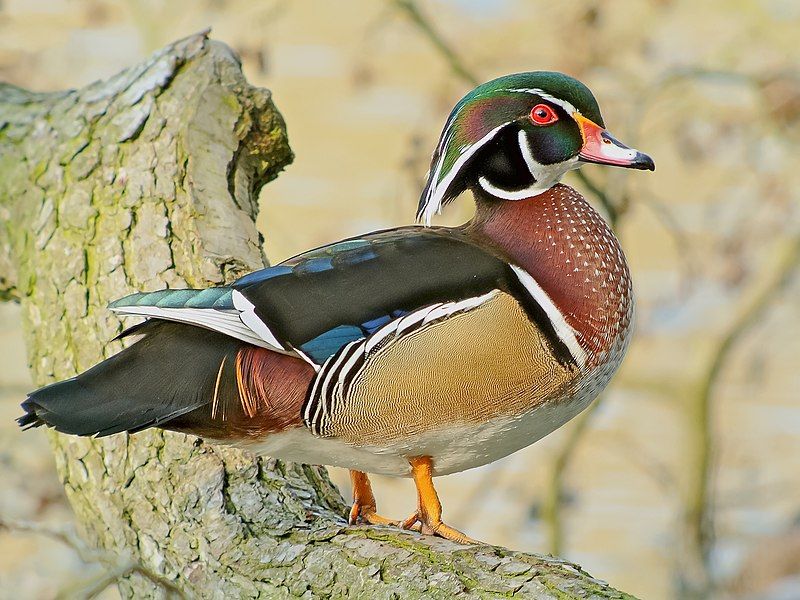
The wood duck, also known as the Carolina duck, is a type of perching duck that can be found in various parts of North America.
These ducks are known for their vibrant and beautiful colors, making them stand out among other waterfowls in the region. The male wood duck, known as a drake, is particularly stunning with its colorful plumage.
It has a combination of bright colors such as green, purple, white, and black. The drake’s head is adorned with a distinctive crest, which adds to its unique appearance. The colorful plumage of the drake wood duck serves various purposes.
One of the main reasons for their bright colors is to attract mates. The vibrant plumage helps the males attract female wood ducks during the breeding season.
The more colorful and vibrant a drake’s plumage, the more likely it is to catch the attention of a potential mate. Another reason for the wood duck’s colorful appearance is camouflage.
Although it may seem counterintuitive, the bright colors of the drake actually help it blend into its surroundings.
The intricate patterns and colors of its plumage mimic the dappled light and shadows found in wooded areas, making it harder for predators to spot them.
| Kingdom | Animalia |
| Phylum | Chordata |
| Clade | Dinosauria |
| Class | Aves |
| Order | Anseriformes |
| Family | Anatidae |
| Genus | Aix |
| Species | A. sponsa |
40. Eastern Screech Owl
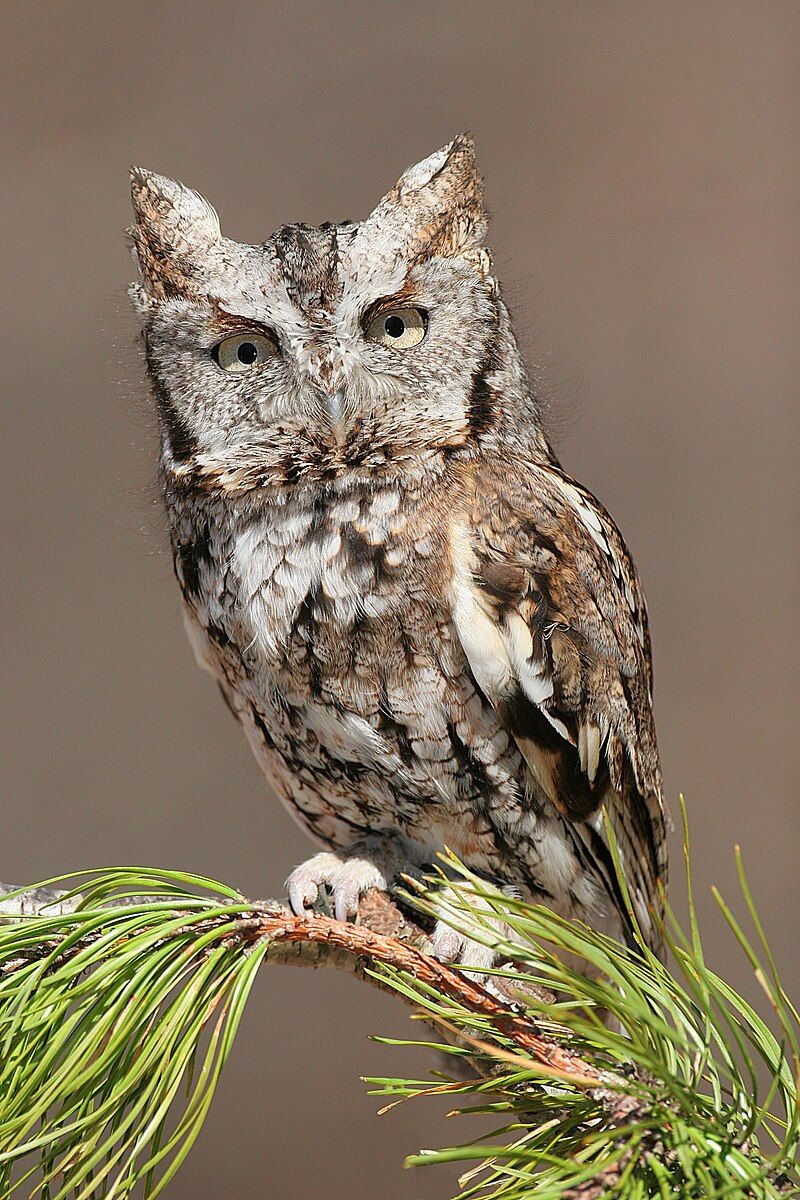
The eastern screech owl, also known as the eastern screech-owl, is a type of small owl. It is commonly found in Eastern North America, spanning from Mexico up to Canada. This owl species is known for its small size, making it relatively easy to identify.
It is not particularly large like some other owl species. The eastern screech owl is considered to be a fairly common sight in its range, which covers a wide geographic area. Despite its name, the eastern screech owl does not only screech.
It has a variety of vocalizations, including whistles and trills. These sounds can be quite distinct and are often heard during the night.
This owl species is known for being vocal and can produce a range of different calls. The eastern screech owl is primarily nocturnal, meaning it is most active during the night.
It spends its days roosting in tree cavities or other hidden areas, using its excellent camouflage to blend in with its surroundings.
This owl’s plumage, or feathers, helps it remain well hidden and protected from predators during the daylight hours. This owl species has adapted well to living in various habitats, including forests, and woodlands.
| Kingdom | Animalia |
| Phylum | Chordata |
| Clade | Dinosauria |
| Class | Aves |
| Order | Strigiformes |
| Family | Strigidae |
| Genus | Megascops |
| Species | M. asio |
41. Yellow-Bellied Sapsucker
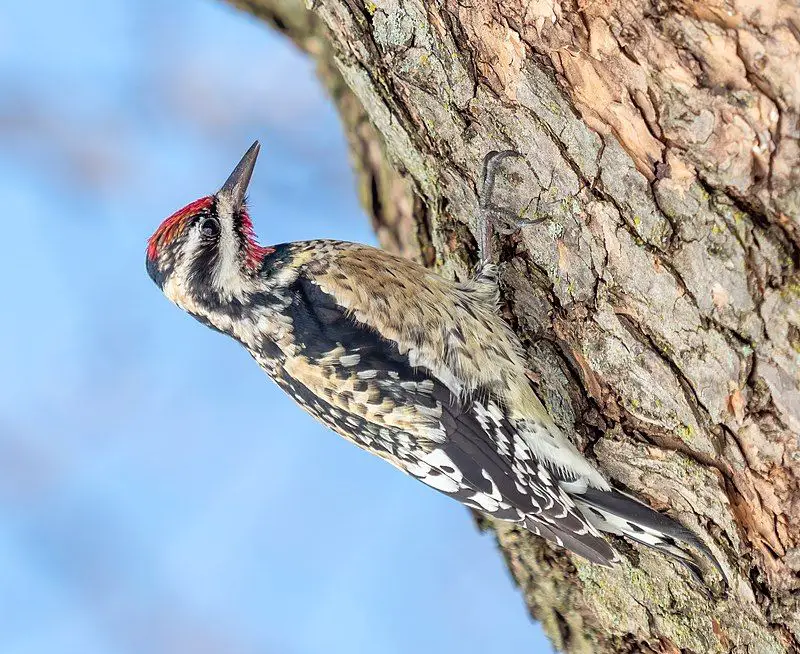
The yellow-bellied sapsucker is a type of bird that belongs to the woodpecker family. It is not too big or too small, but rather a medium-sized bird. This bird can be found in two specific regions, Canada and the northeastern part of the United States.
The yellow-bellied sapsucker is known for its distinct appearance. It has a yellow belly, which is where it gets its name from. This bright yellow color stands out against the bird’s black and white feathers. This woodpecker has a unique behavior when it comes to feeding.
It mainly relies on tree sap as its primary food source. It drills small holes in tree trunks using its strong beak and long tongue to extract the sap. This behavior of drilling holes is why it is called a sapsucker.
Apart from sap, this bird also feeds on insects, fruits, and berries. It has a diverse diet that includes insects like ants, beetles, and caterpillars. Additionally, it enjoys consuming fruits and berries when they are available.
Breeding is an essential aspect of the yellow-bellied sapsucker’s life cycle. It chooses to breed in two specific regions, Canada and the northeastern part.
| Kingdom | Animalia |
| Phylum | Chordata |
| Clade | Dinosauria |
| Class | Aves |
| Order | Piciformes |
| Family | Picidae |
| Genus | Sphyrapicus |
| Species | S. varius |
42. Allen’s Hummingbird

Allen’s hummingbird is a type of hummingbird that can be found in the western part of the United States.
It is one of seven different species of hummingbirds that belong to the genus Selasphorus. These hummingbirds are known for their small size and incredible flying abilities. They are often seen hovering in mid-air or darting quickly from one flower to another.
Despite their tiny size, they have incredibly fast wingbeats, which can reach up to 60 times per second. The breeding range of Allen’s hummingbird is mainly concentrated in the western United States.
They can be found in various habitats such as coastal areas, forests, and even urban gardens.
During the breeding season, the male hummingbirds display their vibrant plumage, which includes a brilliant orange-red throat patch known as a gorget. The female Allen’s hummingbirds, on the other hand, have more subdued colors, with a greenish back and a white breast.
They build small, cup-shaped nests made of plant fibers and spider silk.
These nests are usually constructed in shrubs or trees, providing a safe space for the female to lay her eggs and raise her young. Like other hummingbirds, Allen’s hummingbirds have a specialized diet consisting mainly of.
| Kingdom | Animalia |
| Phylum | Chordata |
| Clade | Strisores |
| Class | Aves |
| Order | Apodiformes |
| Family | Trochilidae |
| Genus | Selasphorus |
| Species | S. sasin |
43. Cooper’s Hawk
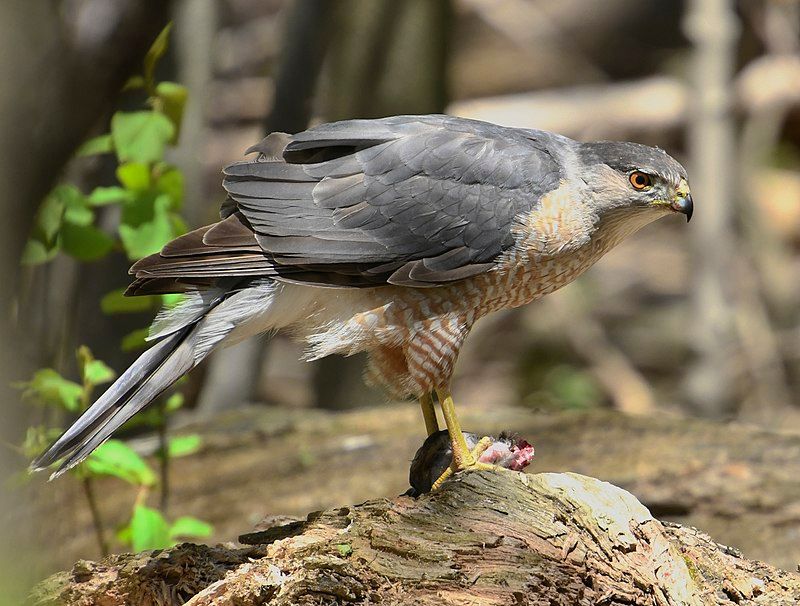
The Cooper’s hawk is a type of hawk that can be found in North America. It is considered to be a medium-sized bird.
This species is native to the continent and is commonly found in various regions ranging from southern Canada down to Mexico. One interesting characteristic of the Cooper’s hawk is its size.
It falls into the category of medium-sized hawks, which means it is neither too big nor too small. This size allows the hawk to adapt and survive in different habitats across North America. The distribution of the Cooper’s hawk is quite extensive.
It can be found in different parts of North America, including southern Canada, the United States, and Mexico.
This wide range of habitats gives the hawk ample opportunities to thrive and establish its presence in various ecosystems. Despite its widespread distribution, the Cooper’s hawk is not evenly distributed throughout its range.
It tends to be more common in certain areas while being less abundant in others. This variation in population density might be influenced by factors such as the availability of prey, nesting sites, and overall habitat suitability. The Cooper’s hawk is known for its hunting skills.
It primarily feeds on small to medium-sized birds, which it catches by surprise using its speed and agility. This hawk is well-adapted.
| Kingdom | Animalia |
| Phylum | Chordata |
| Clade | Dinosauria |
| Class | Aves |
| Order | Accipitriformes |
| Family | Accipitridae |
| Genus | Accipiter |
| Species | A. cooperii |
44. Red-Tailed Hawk
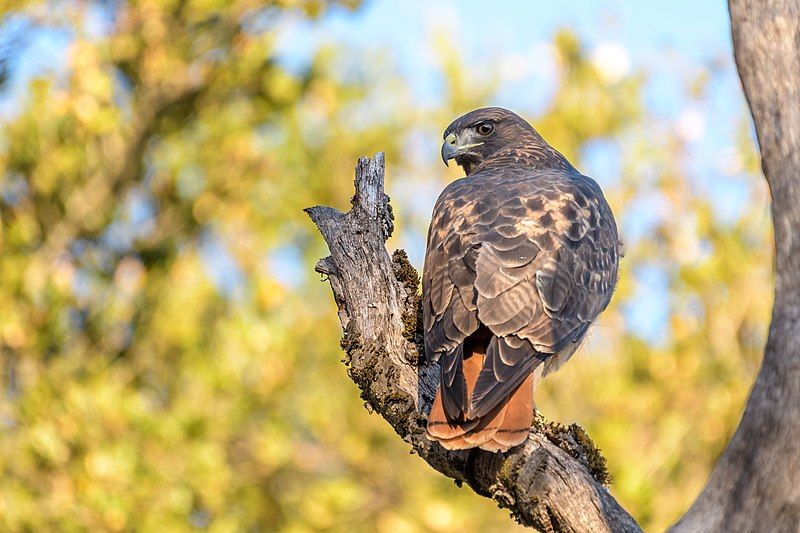
The red-tailed hawk is a type of bird known as a bird of prey. It is found in many different parts of North America. It breeds in a wide range of locations, from the interior of Alaska and northern Canada down to Panama and the West Indies.
This means that you can find red-tailed hawks in many different places throughout North America. The red-tailed hawk belongs to a group of birds called the genus Buteo. This genus includes many different species of hawks.
However, the red-tailed hawk is one of the most common members of this group, both in North America and worldwide.
This means that you are likely to come across a red-tailed hawk more often than other types of hawks within the Buteo genus. The red-tailed hawk is known for its distinctive red tail, which is where it gets its name from.
This feature helps to distinguish it from other types of hawks. However, it is important to note that not all red-tailed hawks have red tails.
Juvenile red-tailed hawks have brown tails, which only turn red as they mature. Red-tailed hawks are known for their impressive hunting skills. As birds of prey, they primarily.
| Kingdom | Animalia |
| Phylum | Chordata |
| Clade | Dinosauria |
| Class | Aves |
| Order | Accipitriformes |
| Family | Accipitridae |
| Genus | Buteo |
| Species | B. jamaicensis |
45. Eastern Phoebe
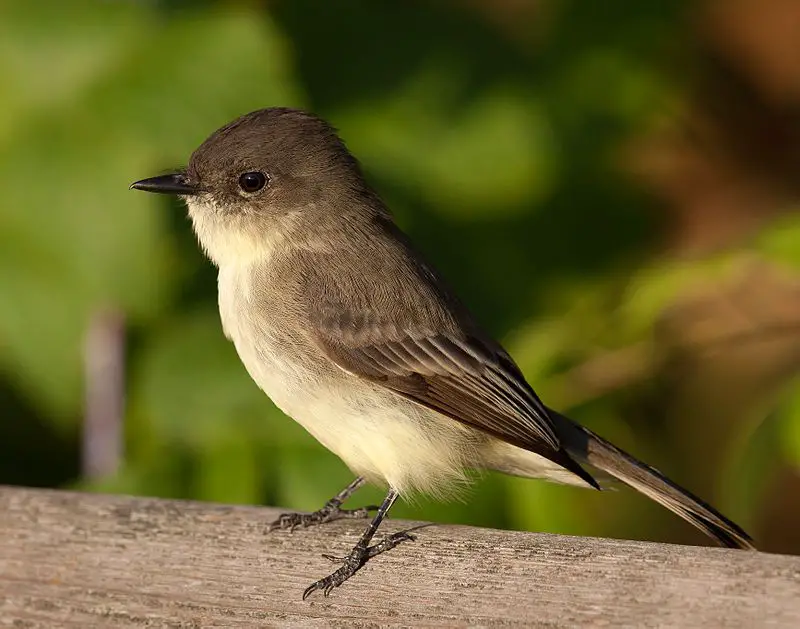
The eastern phoebe is a small bird that belongs to the passerine family. This family includes birds that have feet specially adapted for perching, singing, and eating seeds or insects.
The eastern phoebe is one of these birds. The scientific name of the eastern phoebe is Sayornis. This name is derived from the specific part of Charles Lucien Bonaparte’s name for Say’s phoebe, another closely related bird species.
Charles Lucien Bonaparte was a French ornithologist who discovered and named several bird species. The specific name for Say’s phoebe, Muscicapa saya, was taken by Bonaparte and combined with the Ancient Greek word “ornis,” which means “bird.” This combination resulted in the genus name Sayornis for the eastern phoebe. The genus name is essential in scientific classification because it helps scientists categorize and identify different species.
By using a standardized system of naming, scientists can communicate more effectively about specific birds and their characteristics. In this case, the genus name Sayornis indicates that the eastern phoebe is closely related to Say’s phoebe.
It helps scientists understand the evolutionary relationships between these two species.
| Kingdom | Animalia |
| Phylum | Chordata |
| Clade | Dinosauria |
| Class | Aves |
| Order | Passeriformes |
| Family | Tyrannidae |
| Genus | Sayornis |
| Species | S. phoebe |
Conclusion
Winter birds in Delaware offer a delightful sight for birdwatchers and nature enthusiasts.
With a variety of species migrating to the state during this season, including the iconic snowy owl and bald eagle, Delaware’s winter bird population is diverse and impressive.
These birds not only add beauty to the winter landscape but also play a vital role in maintaining the ecological balance of the region.
The efforts of birdwatching groups and conservation organizations in protecting and preserving the habitat of winter birds in Delaware have been crucial in ensuring their continued presence.
As winter approaches, residents and visitors alike can look forward to witnessing these magnificent creatures and appreciating the wonders of nature in Delaware.